Colloquia & Events
Spring 2025
If you need any accommodations or have any questions, please email linguistics@utah.edu. If you would like to receive announcements on upcoming events please sign up here or email us and ask to be added to the ling-announcements listserve | View Past Events
More details will be posted.
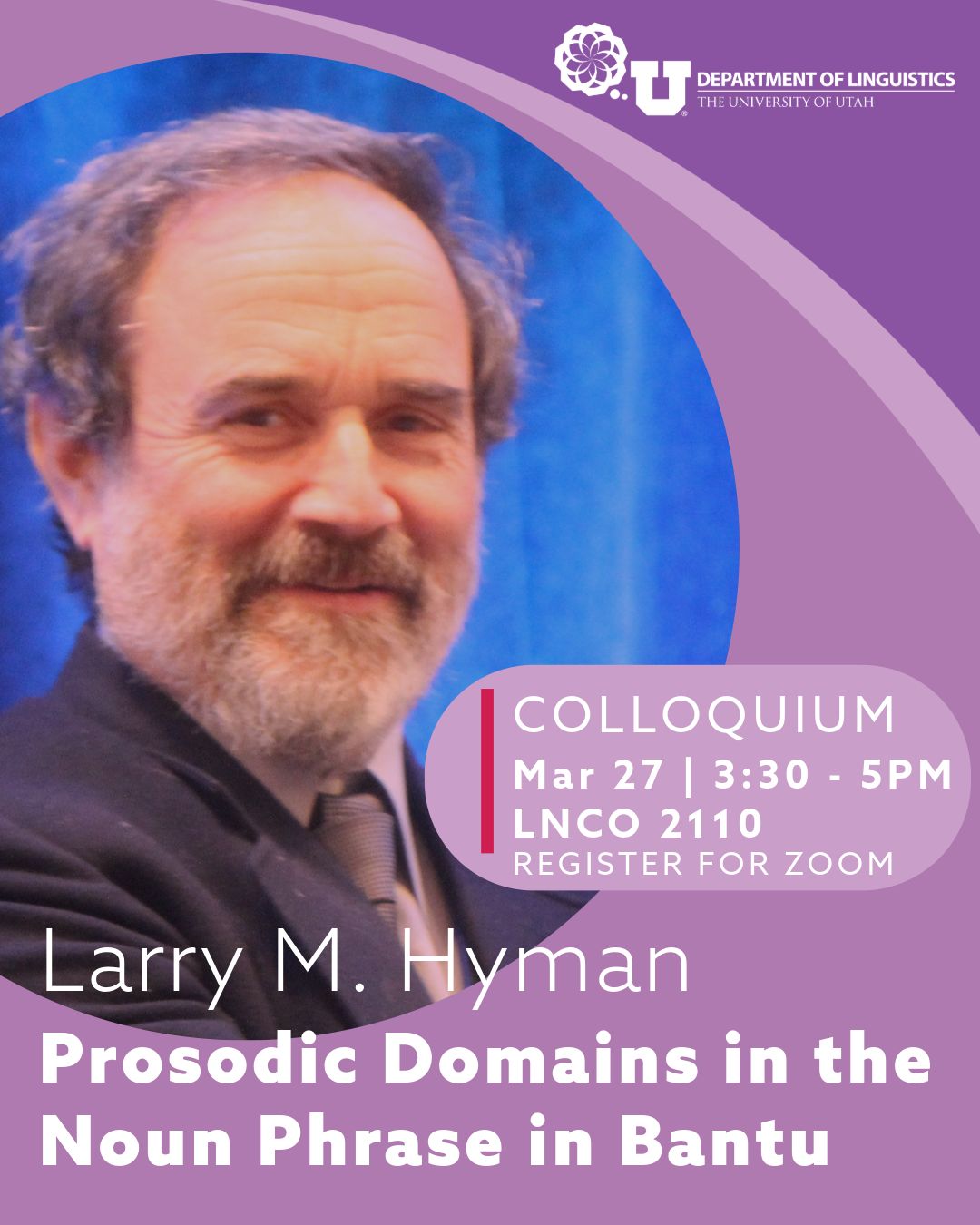
Colloquium - Larry Hyman
Prosodic Domains in the Noun Phrase in Bantu
Mar 27 | 3:30-5pm | LNCO 2110 Watch Now
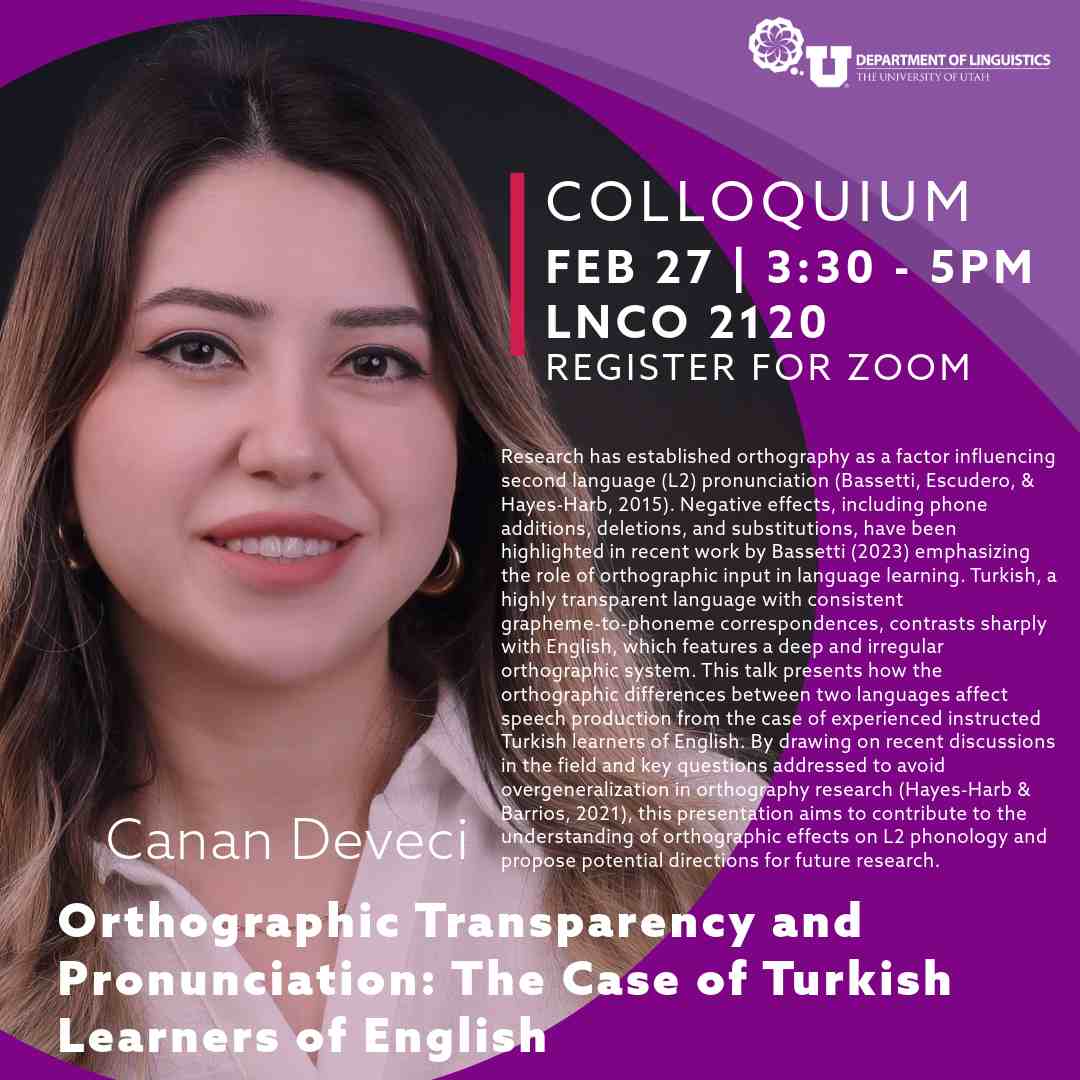
LOACATION CHANGED TO LNCO 2910
Colloquium - Canan Deveci
Orthographic Transparency and Pronunciation: The Case of Turkish Learners of English
Feb 27 | 3:30-5pm | LNCO 2910

Colloquium - Andrés Buxo-Lugo
Suprasegmental Cues as a Window Into Phonological and Prosodic Encoding in Production
Feb 13 | 3:30-5pm | Watch Now
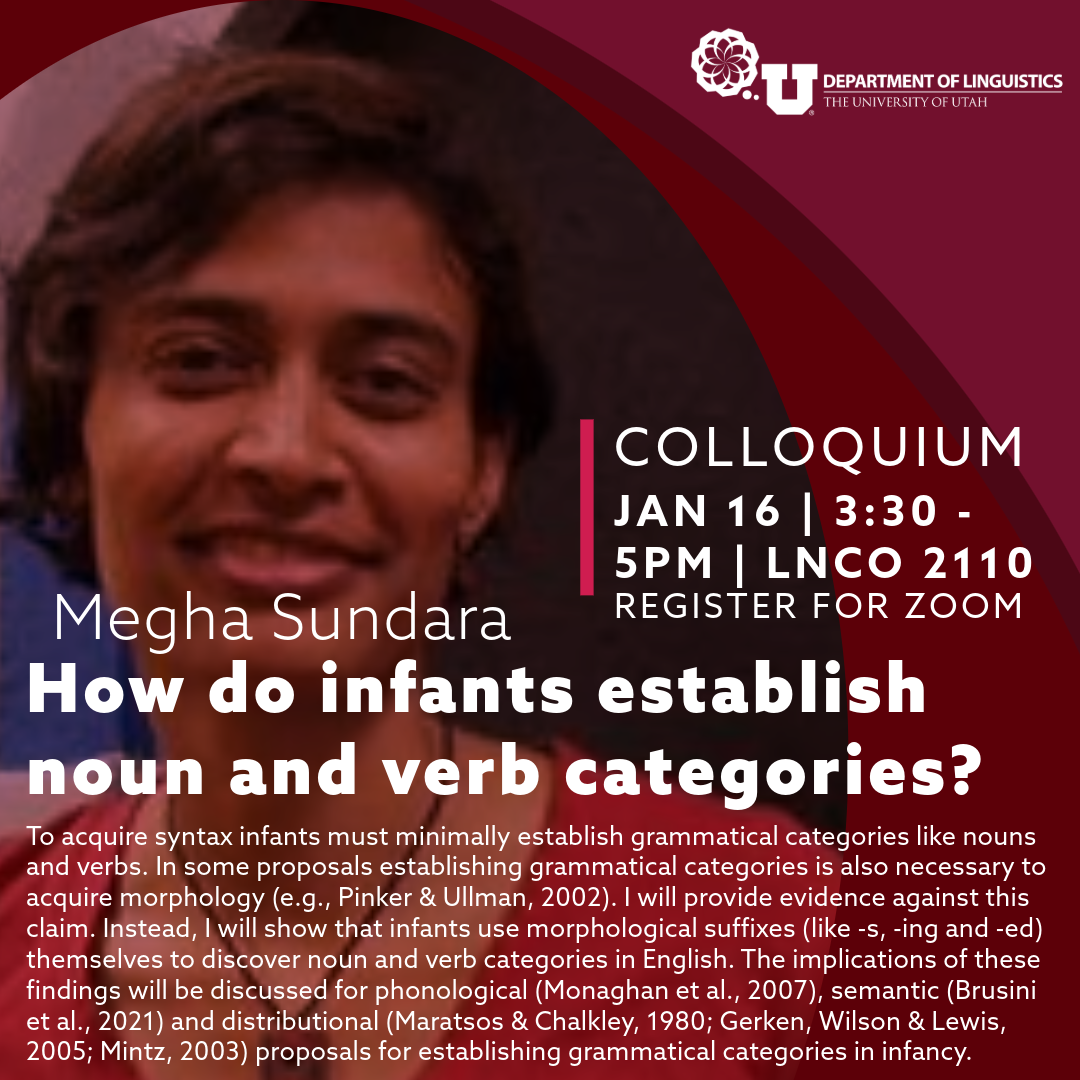
Colloquium - Megha Sundara
How do infants establish noun and verb categories?
Jan 16 | 3:30-5pm | LNCO 2110 or Zoom

Stay tuned for upcoming events!
2025
Coming soon!
2024

Celebrate the New Year and a new semester with us! Jan 16th 11am-3pm LNCO 2945
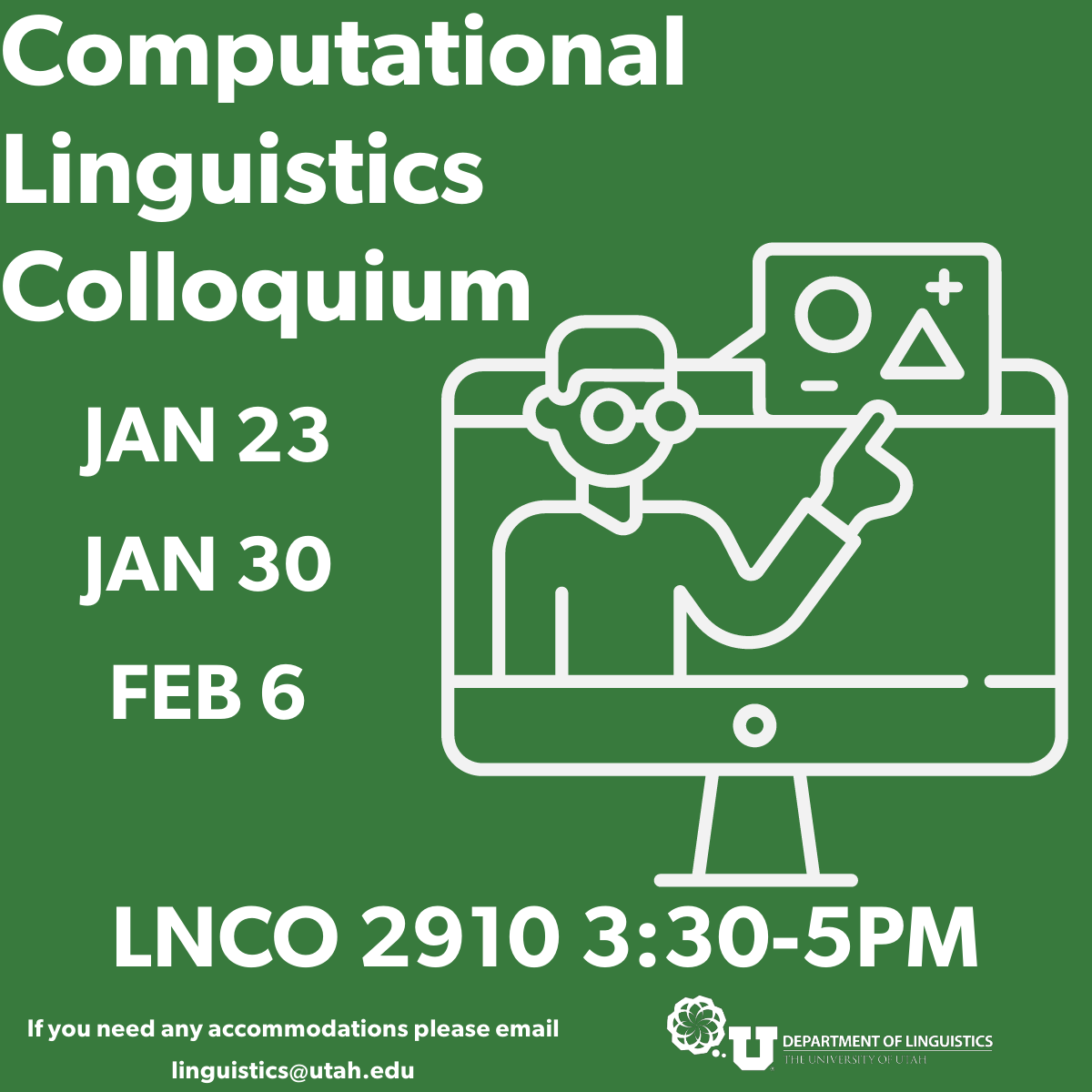
Computational Linguistics Colloquium Series
3:30-5pm LNCO 2910
Jan 23 | Jan 30 | Feb 6
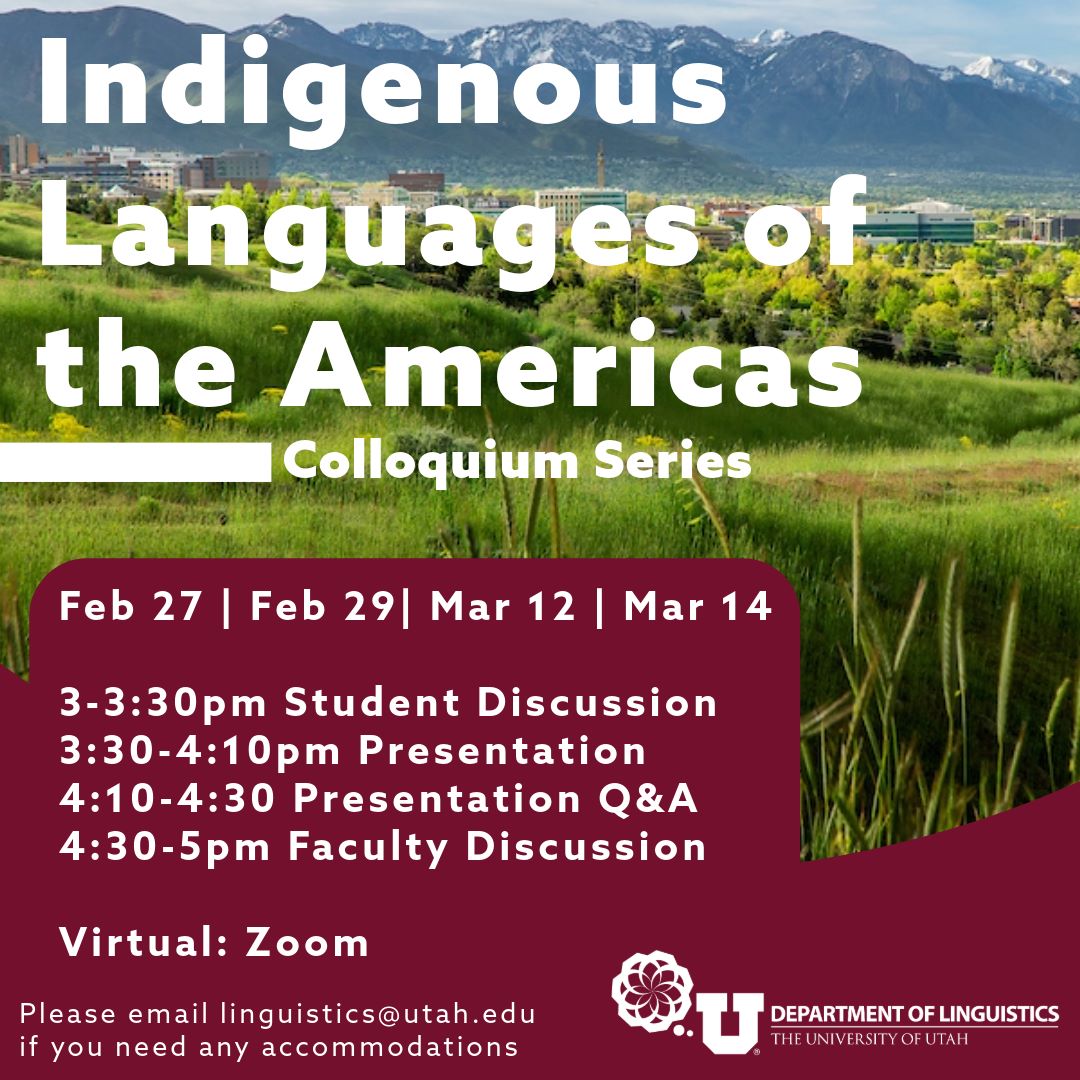
Indigenous Languages of the Americas Colloquium Series
3-5pm Virtual
Feb 27 | Feb 29 | Mar 14
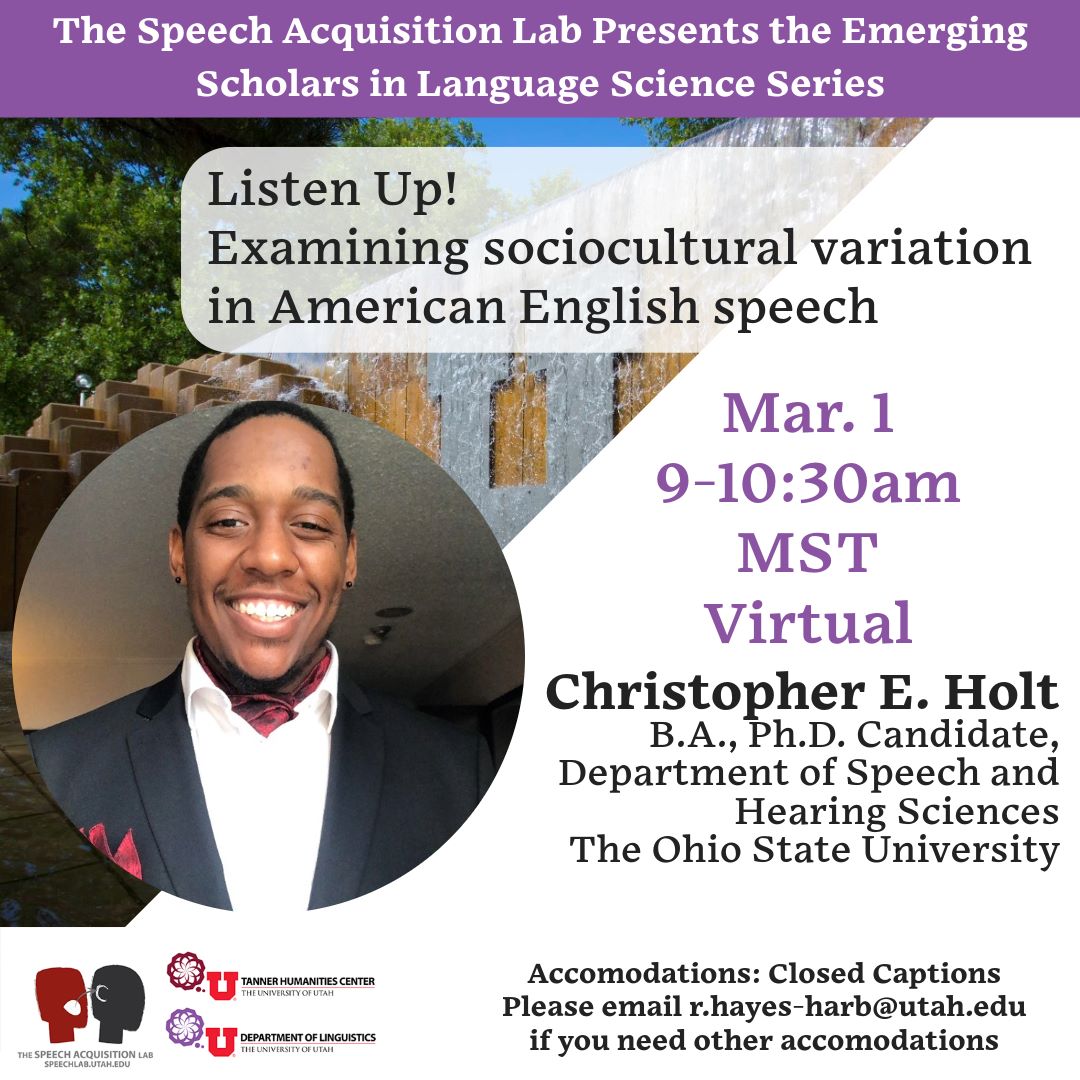
Christopher E. Holt - Listen Up! Examining sociocultural variation in American English speech
Mar 1st 9-10:30AM Virtual
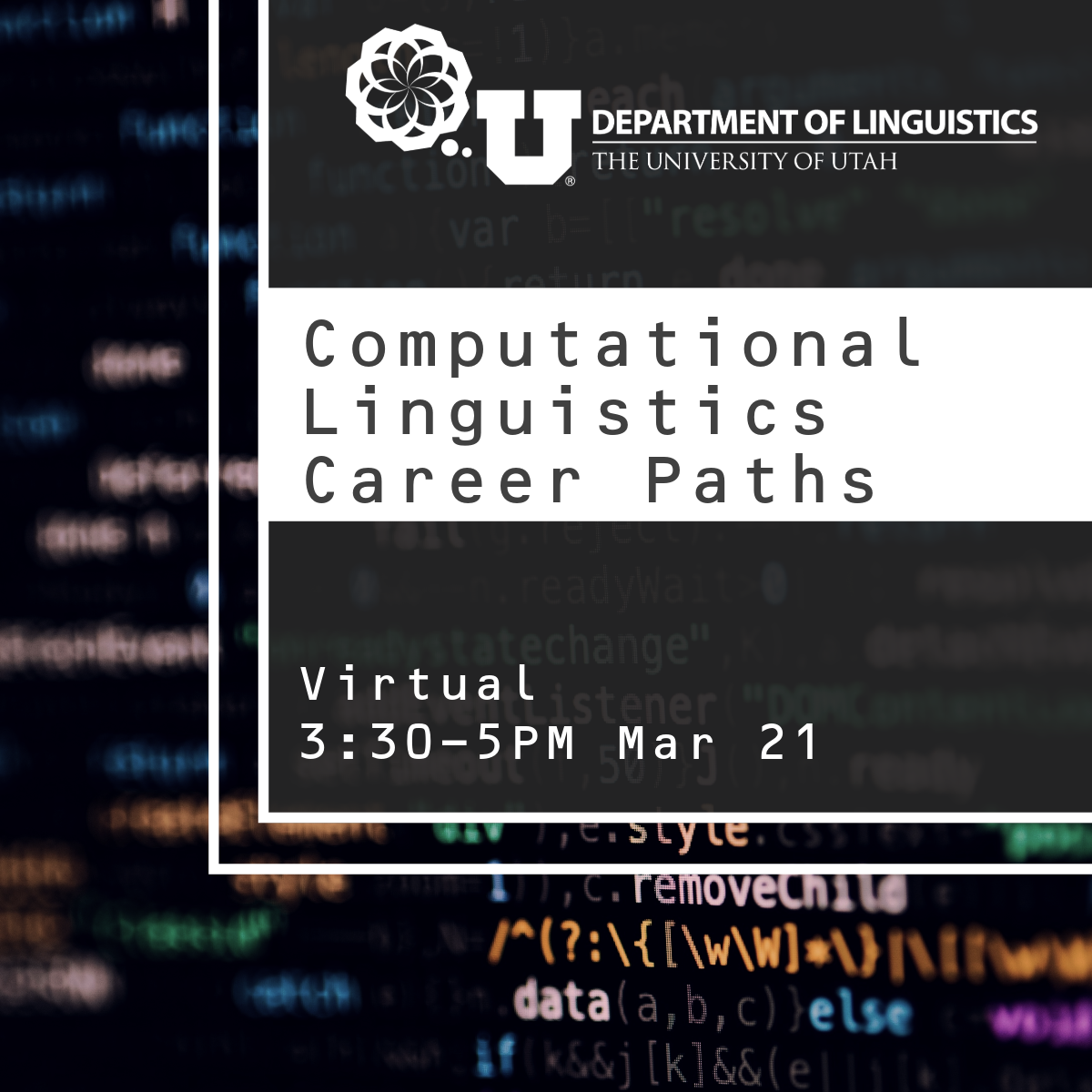
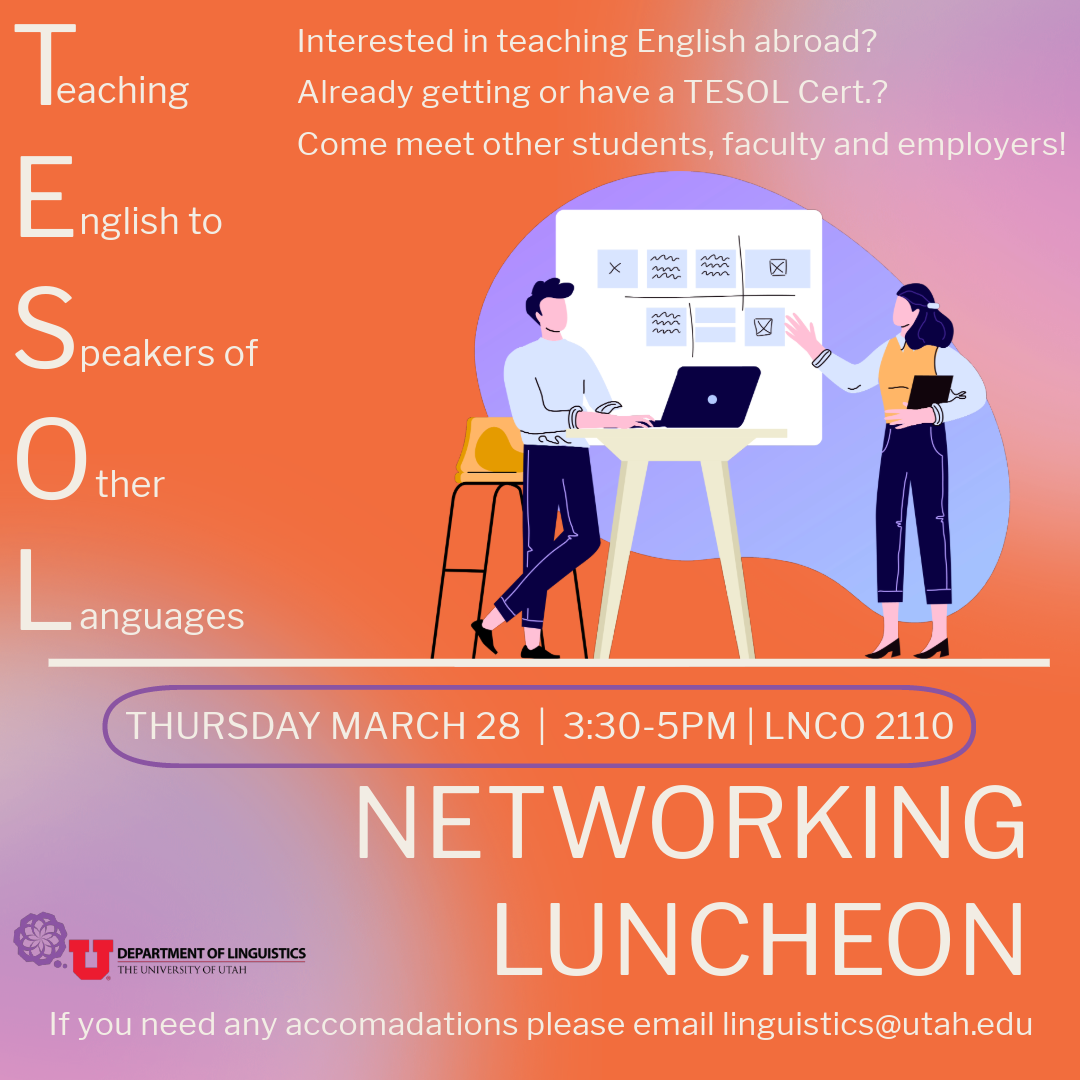
TESOL Networking
Mar 28th 3:30-5PM LNCO 2110
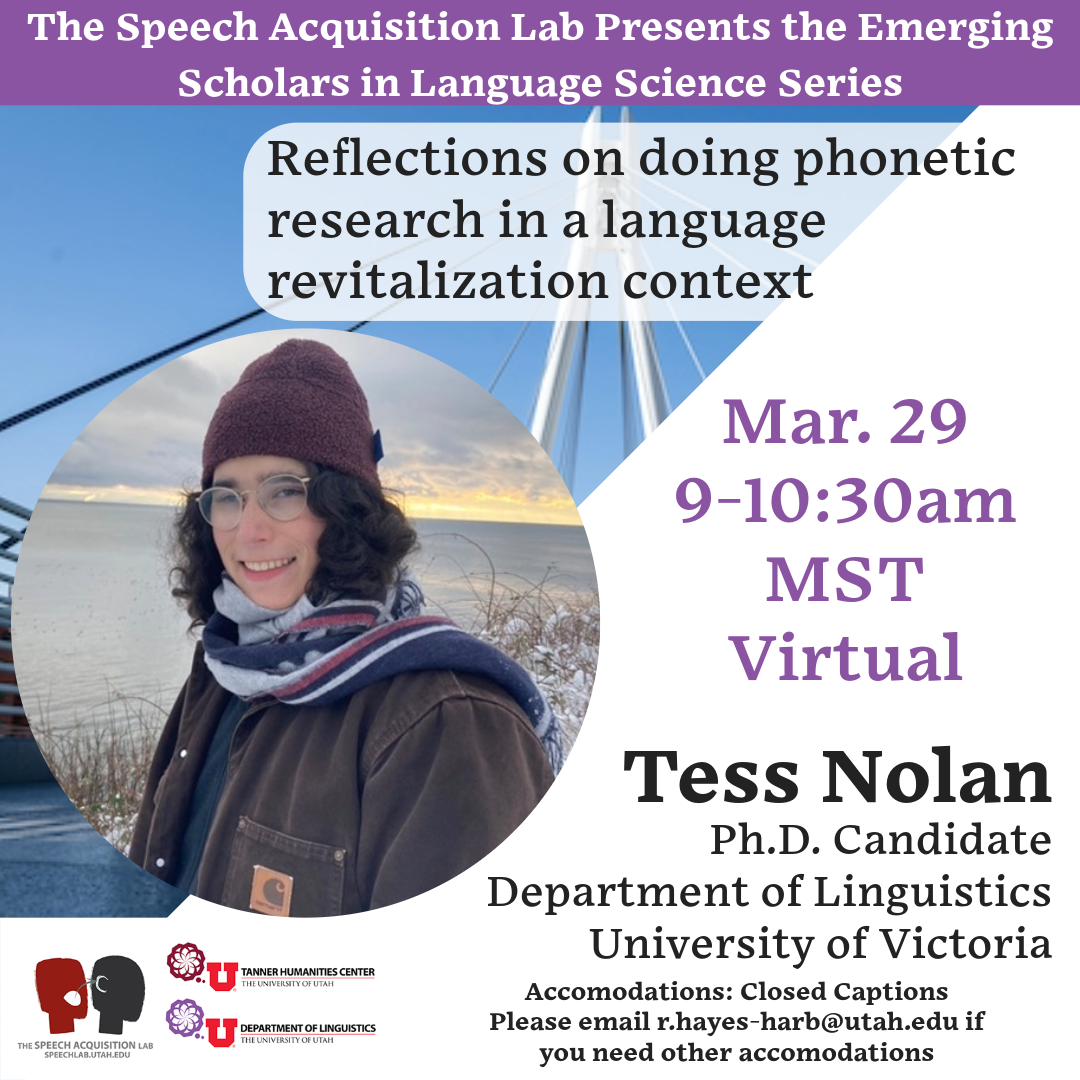
Tess Nolan - Reflections on doing phonetic research in a language revitalization context
Mar 29th 9-10:30AM Virtual

Colloquium - Benjamin Bruening - Accounting for a Mysterious Prefix in Algonquian Languages
Apr 4th 3:30-5pm LNCO 2110

Details coming soon!

THIS EVENT HAS BEEN CANCELED
Colloquium - Laurel Perkins
CANCELED
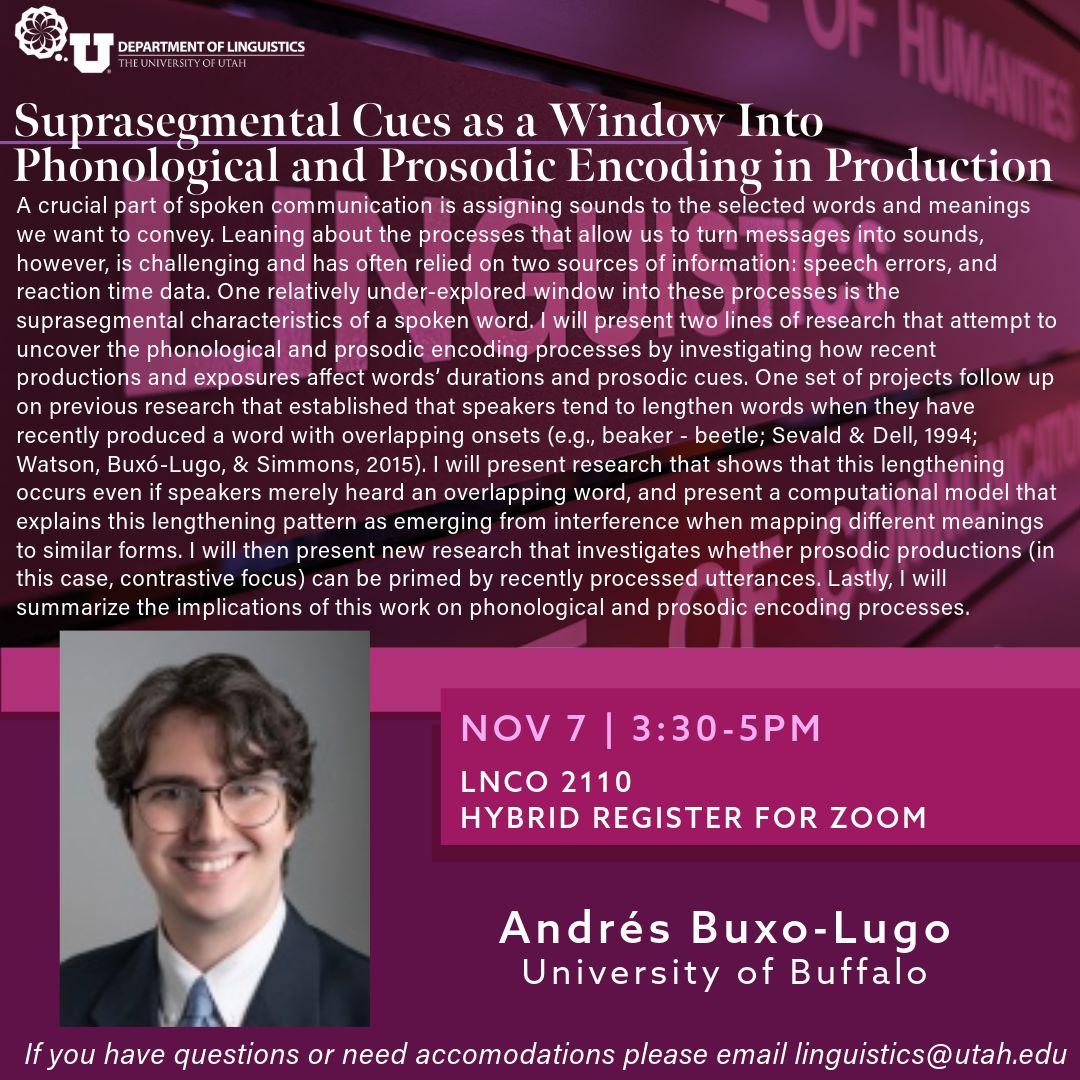
THIS EVENT HAS BEEN CANCELED
Colloquium - Andrés Buxo-Lugo
CANCELED
Colloquium - Arkadiusz Rojczyk
Oct 22 | 3:30-5pm | LNCO 2110
Modern Technologies in Second-Language Speech Research
Colloquium - Cassandra Jacobs
Oct 3 | 3:30-5pm | LNCO 2110
How Context and Competition Constrain Language Production
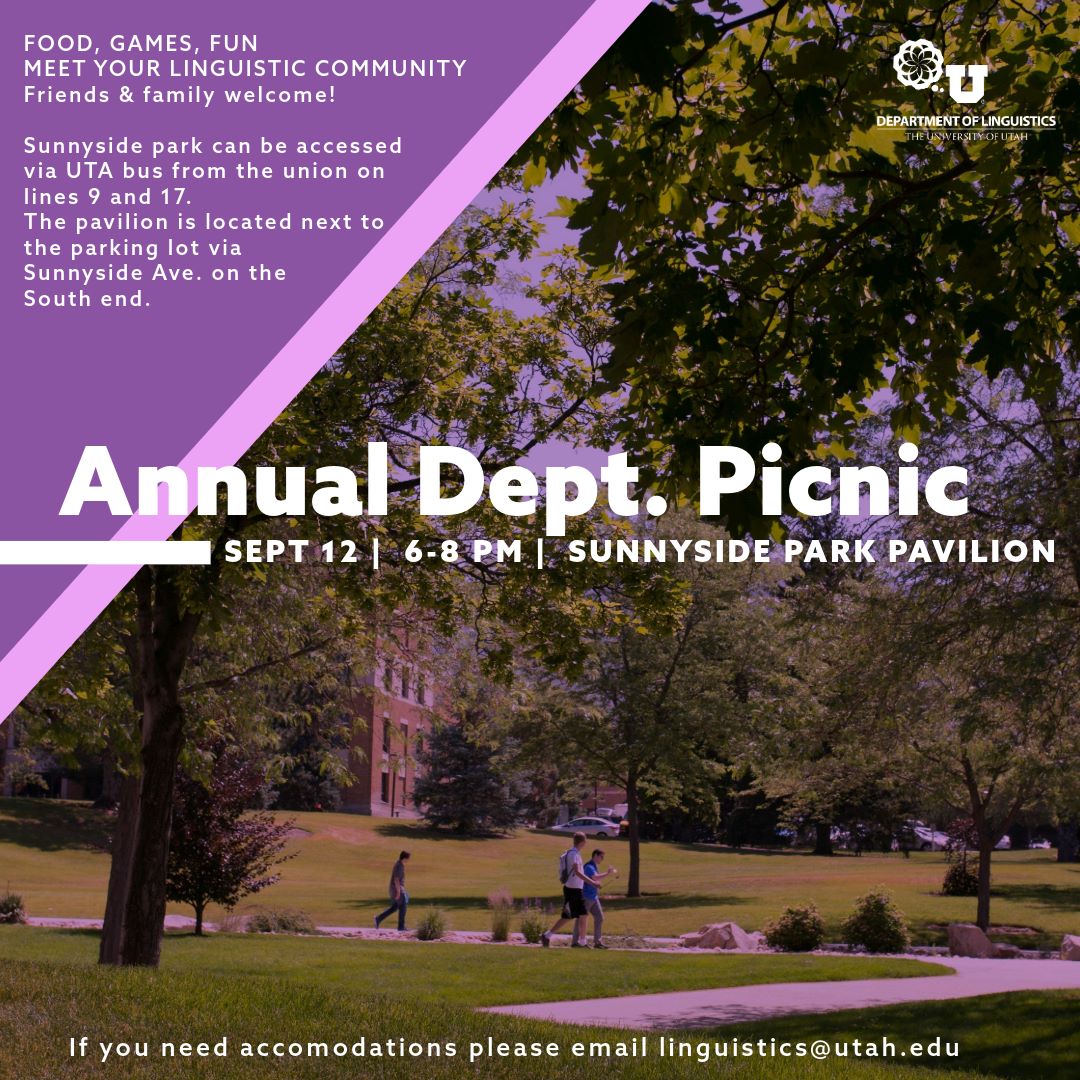
Annual Dept. Picnic
Sept 12 | 6-9pm | Sunnyside Park Pavilion
Get to know everyone in the department! Staff, faculty, students and friends/families welcome :D
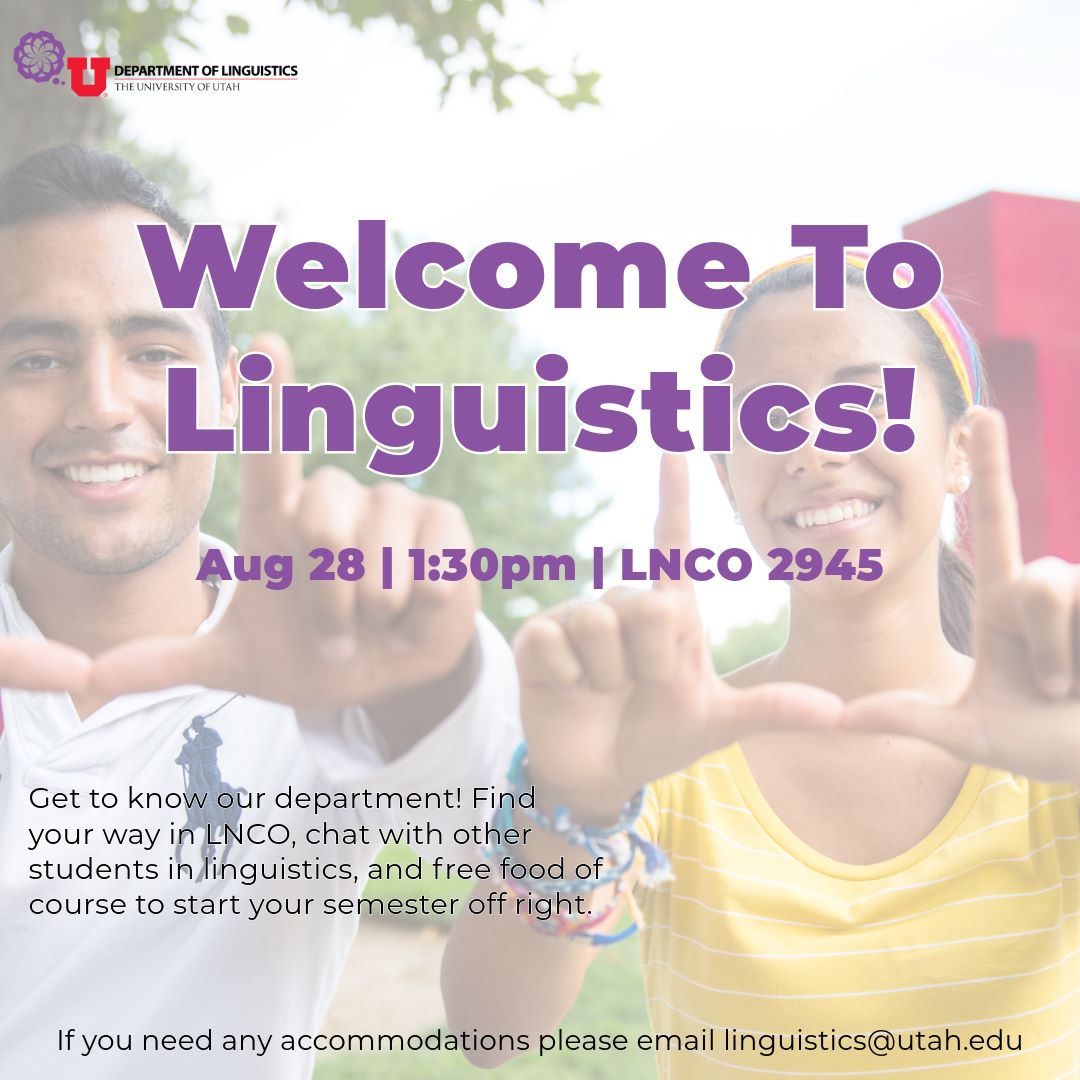
Welcome (back) to Linguistics!
Aug 28 | 1:30 | LNCO 2945
Stop by the office to meet your advisor, faculty and staff, check out study space and pick up Freshman/Transfer swag!
2023
Jan 12th 11am(ish) LNCO 2300
Welcome Back! Spring Social
Happy New Year! Get to know new and old students and of course free food (while supplies last). Stop by the main office anytime between your classes after 11am.
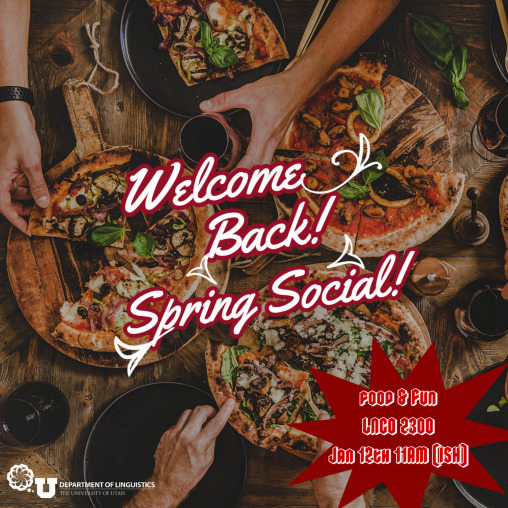
Feb 23rd 3:30-5PM LNCO 2110 & Zoom
Linguistics Colloquium- Dr. Benjamin Slade, University of Utah

Khā lo yā nikal jāo! “Eat up or get out!”: L2 acquisition of Hindi verb+verb collocations
Hindi V+V compounds, of the type exemplified by khā liyā “ate up” (lit. “eat took”), are a central part of idiomatic fluent Hindi speech. However, the rules governing not only possible combinations but also how the use of a V+V collocation affects other aspects of the clause, as well as the semantic contribution of the light verb, are all complex and involve idiosyncratic components; and thus pose a challenge to second language learners of Hindi. This is true not only for learners whose L1 is a non-Indo-Aryan language, but also for L1 speakers of other Indo-Aryan languages. Hindi V+V compounds, both in terms of their functions (e.g. aspect, speaker affect) and in terms of their idiomaticity are reminiscent of English verbal particle constructions (e.g. “eat up”), and L2 instructional techniques developed for the latter potentially relevant for Hindi V+Vs.
Mar 2nd 3:30-5PM Virtual
Linguistics Career Pathways- Speech Language Pathology
Join us for a Q&A discussion with a panel of professional Speech Language Pathologists.
Mar 30th 3:30-5PM Virtual
Linguistics Colloquium- Dr. Kelly E. Wright
Awareness, Objectification, & Equity
Linguistics in a Hostile Workplace
Metalinguistic awareness includes a language user’s knowledge about the relation of factors (like age, gender, or race) to linguistic usage, distribution, meaning, or context of occurrence variance (Wright 2022). Such embodied knowledge (Bucholtz & Hall 2016) is directly linked to the social meanings available to an individual across linguistic markets (Bourdieu 1977; Zhang 2005), and thus illuminates the ways in which linguistic markets (and the social meanings enacted through them) are simultaneously responsive both to personally held aspects of identity and the extant sociohistorical facts which afford identities their social power.
Wright will begin this presentation with a discussion of how embodied perception–stretched over time–interacts with institutions to create the conditions for linguistic oppression. With this knowledge base, the consideration will shift to raciolinguistic ideologies (Flores & Rosa 2015) and the extent to which they constrain one’s capability of exploiting the range of expectations available in a given context. Wright will then observe, in this light, the remarkable challenge of objectifying language data and present an innovative methodology–designed to elicit metalinguistic commentary and that stemmed from a desire to introduce representative and equitable models of data collection and experimentation: the metalinguistic method of sociolinguistic interview (Wright 2022). This talk will end with an active, large group discussion on this central issue of linguistic inquiry and the ways in which we–as a community of experts–can balance approaching empirical validity on one end and radical acceptance on the other.
Apr 14th 9AM-5PM LNCO 2110 & 1100
University of Utah Student Conference In Linguistics (UUSCIL)
UUSCIL provides an opportunity for Linguistics students to present their research in a scholarly setting to members of the Linguistics community at the U. Come support your peers and learn about the cool things going on in Linguistics research!
Apr 20th 4PM-6PM Cleone Peterson Eccles Alumni House Executive Boardroom and Patio
Open House for departing and retiring faculty.

We’d like to offer our many thanks and to congratulate our amazing faculty on thier new adventures. They will be greatly missed.
Apr 25th 10AM-5PM LNCO 2300
Spring Finals Destress Activity
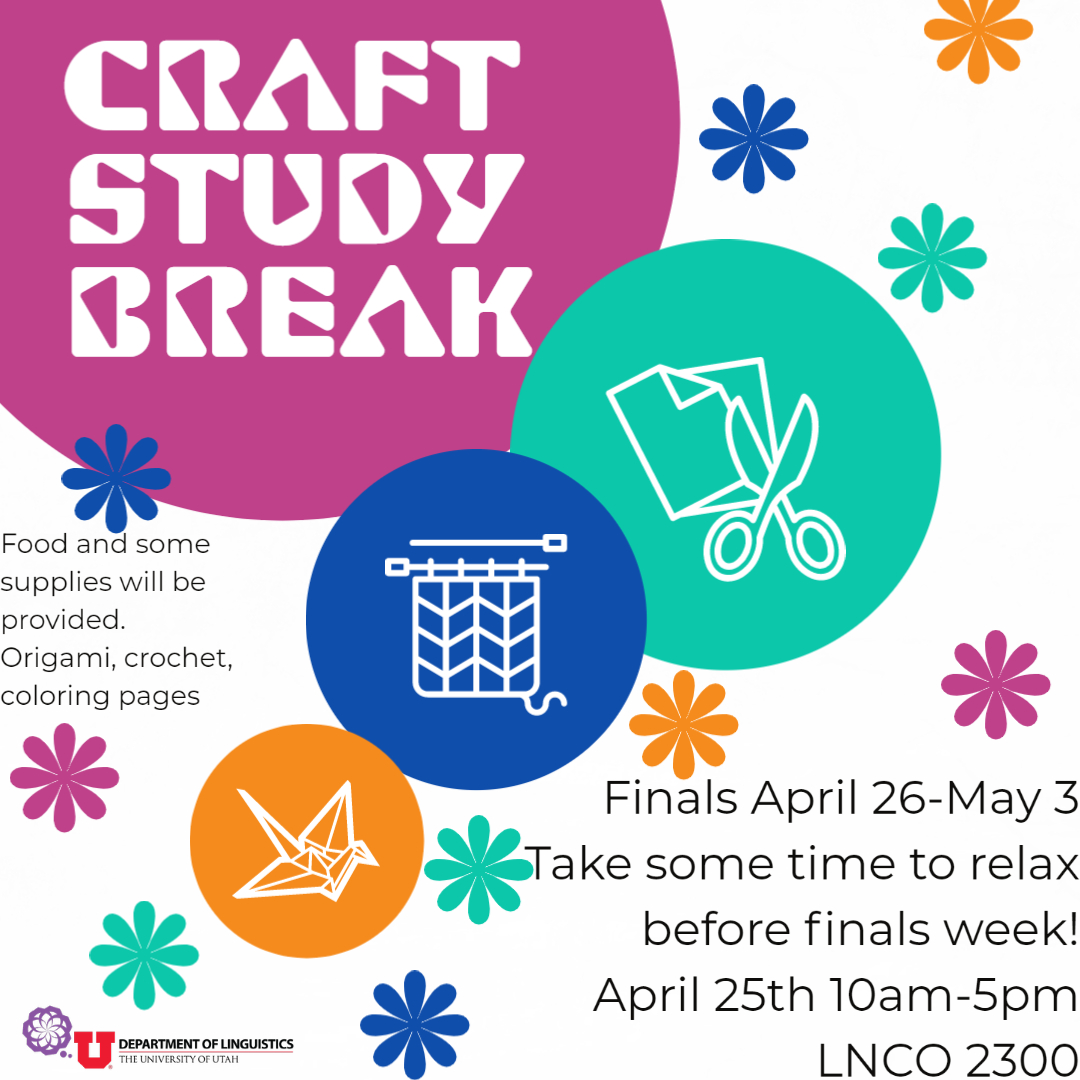
Take a study break and get those creative juices flowing. Join us for arts and crafts, of course food, drinks, and socializing. Some supplies will be provided for yarn and paper arts, origami, and coloring pages, but feel free to bring you're own or something to share!
Sept 7th
5-9pm Sunnyside Park Pavilion
Welcome (Back)! Department Picnic
Sunnyside Park 1735 Sunnyside Ave. S, Salt Lake City, UT 84108. UTA bus accessable from the Union on lines 9 (Bay B) or 17 (Bay D). Catering will be provided by Tamarind. Please join us with your friends and/or family!

Sept 11th
3-4:30pm LNCO 2945
Are you interested in learning more about Computational Linguistics? Are you already enrolled in the Comp Ling certificate? Come meet others with similar interests, faculty mentors, and advisors!

Sept 20th
9-11:30am LNCO 2945
Brunch Open House
Miss the Dept. Picnic? No problem! Stop by before class to grab a bite and say hi to your favorite linguists!

Oct 20th
10-11:30am Virtual

The Speech Acquisition Lab presents the Emerging Scholars in Language Science Series
Elijah Wilder, PhD student in Linguistics, University of Texas - Austin
Diachrony of stress change: A reconstruction of proto-Mayan stress parameters
The Mayan language family consists of roughly 30 languages spoken throughout Southern Mexico and Guatemala. Stress patterns in the family are under-studied, but what descriptions do exist show several different stress patterns that do not adhere to genetic relation and can differ dramatically between varieties of the same Mayan language. I propose that these differences in stress patterns can be broadly classified into two stress patterns, a quantity-sensitive pattern and a quantity-insensitive pattern.
By analyzing stress descriptions of languages belonging to either stress pattern, a set of parameters for stress assignment frequently appears. I propose that those parameters can be reconstructed to proto-Mayan. Additionally, by selecting for these parameters, it is possible to discern the ways in which Mayan languages changed to create the variety in stress patterns found in the modern languages.
Oct 26th
3:30-5pm Hybrid LNCO 2945 & Virtual
Career Paths: Unified Languages
A panel of professionals discuss internships, employment options and their experience in the field.
Nov 2nd
3:30-5pm Hybrid GC 2660 & Zoom
Colloquium: Sonca Vo, Postdoctoral Scholar University of Utah
Investigation into the factor structure of a local English placement test of oral communication
This study describes the development process and examines the construct validity of an English placement test of oral communication (EPT OC) developed at a Midwestern university in the United States. This test includes a one-on-one oral interview and paired discussion task, and test performance is judged on an analytic rating scale. A confirmatory factor analysis conducted on the ratings of 338 students who took the initial fully operational EPT OC revealed the test structure was represented by a correlated four-factor model with interactional competence, fluency, pronunciation/comprehensibility, and grammar/vocabulary as sub-constructs, in line with its targeted theoretical framework. Both tasks were effective in measuring the targeted sub-constructs, but the sub-constructs were not sufficiently distinct from each other to completely justify a four-factor model. The findings provide some support for the proposed interpretations of the EPT OC test scores but indicate the need for some modifications to the assessment, such as more thorough rater training and/or revised rating scales to better distinguish the targeted sub-constructs
Nov 9th
3:30-5pm Hybrid GC 2660 & Zoom
CONTENT WARNING! Vulgar Language
Colloquium: Randall Eggert, Assistant Professor (Lecturer) University of Utah
Toward a Lexically Realistic Semantics of Taboo (and other) Words
Sadock (1994: 396) argues there are “simultaneous, independent, orthogonal communicative dimensions” to natural language. He then proposes three communicative aspects to acts of speech: informational, social, and emotional. Sadock’s focus is on speech acts and conversation; however, we can conclude that if these communicative functions exist, there must be conventional correlates in language proper. In other words, the same three aspects can be found in the meaning of words, i.e. lexical semantics. In this paper, I demonstrate the necessity for these three independent aspects of meaning in lexical semantics by closely examining the meaning of certain taboo words.
Nov 16th
3:30-5pm Hybrid GC 2660 & Zoom
Colloquium: Sopuruchi Aboh, Department of English and Communication, The Hong Kong Polytechnic University
Understanding and examining attitudes towards Nigerian Englishes
Research has shown the existence of localised or naturalised Englishes in Nigeria,
primarily attributed to the impact of the first language (Nigerian indigenous language)
on English language usage. From an ethnic perspective, the major localised Englishes
are Hausa English (HE), Igbo English (IE) and Yoruba English (YE), spoken by the three
major ethnolinguistic groups in Nigeria. From an attitude perspective, this talk will
provide a background to language attitude research and Nigeria’s linguistic landscape,
and present the findings of ongoing research on the attitudes of Nigerian students
towards these Nigerian Englishes. The talk also summarises the findings on the association
between ethnic categorisation and underlying reasons for categorising Nigerian Englishes.
The talk highlights the contribution of the findings to the understanding of discrimination
against language varieties and the sociopsychological processes that underlie accent
recognition and ethnic categorisation of accents. This understanding can help in challenging
stereotypes related to language varieties, promoting inclusivity, and fostering linguistic
tolerance.
Nov 17th
10-11:30am Virtual
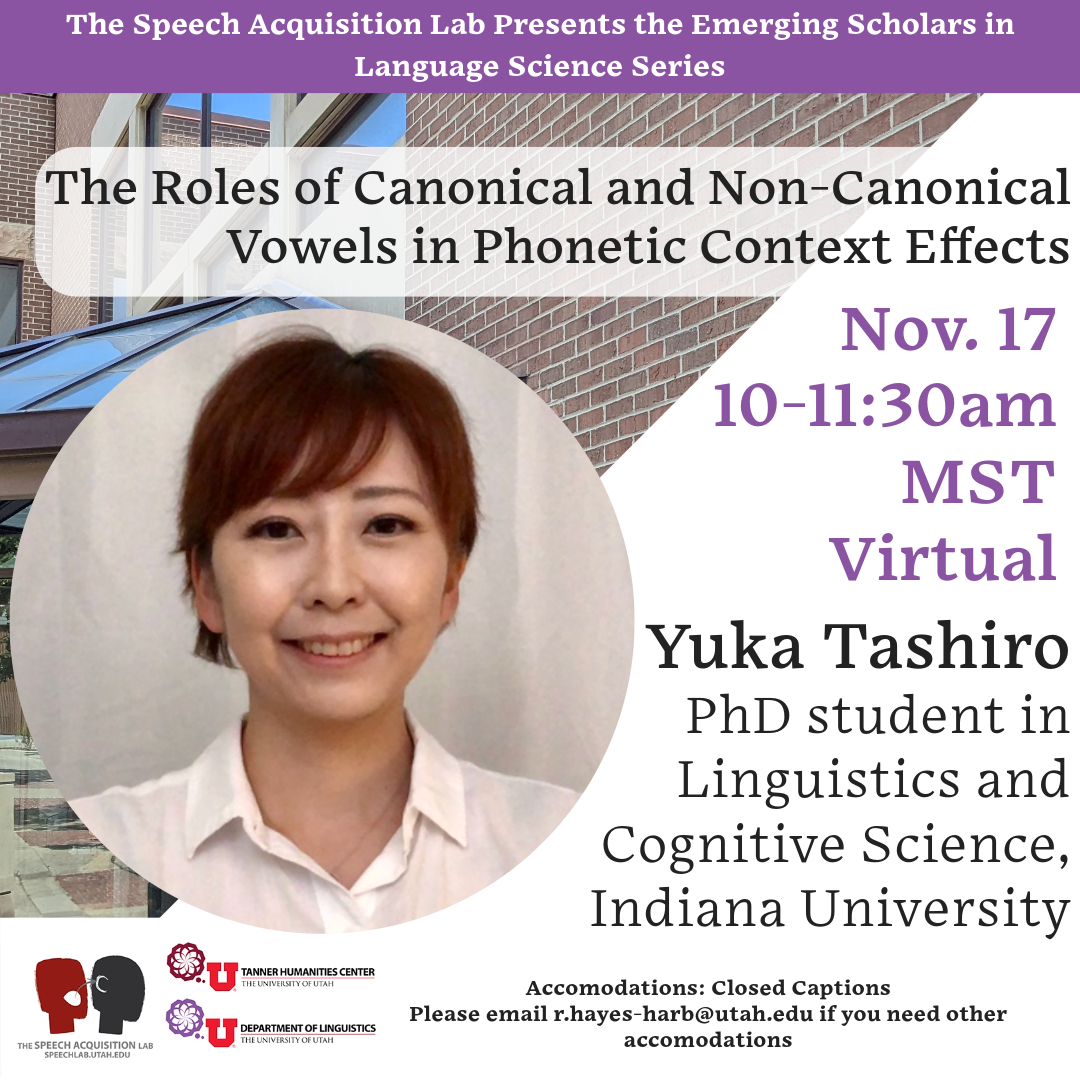
The Speech Acquisition Lab presents the Emerging Scholars in Language Science Series
Yuka Tashiro, PhD student in Linguistics and Cognitive Science, Indiana University
The Roles of Canonical and Non-Canonical Vowels in Phonetic Context Effects
Despite of the lack of invariance problem in the acoustic signal (Liberman et al., 1967), listeners generally seem to be successful at retrieving speakers' intended phonemes. How do listeners parse coarticulated speech given the high nature of acoustic context-sensitivity? Earlier studies (e.g., Kunisaki & Fujisaki, 1977; Mann & Repp, 1980) have discovered that listeners' parsing behaviors reflect listeners' shifting the categorization of a target sound according to a preceding or following phonetic context (known as phonetic context effects, Repp, 1982). According to the literature, there are two types of phonetic context effects, which I refer to as dissimilative parsing (e.g., Kunisaki & Fujisaki, 1977; Mann & Repp, 1980) and assimilative parsing (e.g., Fujimura et al., 1978; Rysling et al., 2019) in the current study. In a dissimilative parsing, listeners parse two successive segments to identify one as more different from the other, while in an assimilative parsing, listeners parse two successive segments in a way that identifies one as more similar to the other. For example, an ambiguous target fricative noise between [s] and [ʃ] may be identified as [s] more often when its phonetic context is [u] than [i] for a dissimilative parsing, but the target sound may be identified as [ʃ] more often when its phonetic context is [u] than [i] for an assimilative parsing. When do listeners decide to use a dissimilative parsing over an assimilative parsing, and vice versa? More recently, Rysling et al. (2019) suggested that a dissimilative parsing is the default mechanism of parsing, but listeners do an assimilative parsing in particular when an ambiguous target is immediately followed by its phonetic context with smooth continuous spectral transitions. Hence, an assimilative parsing should not happen when a sibilant fricative noise is a preceding ambiguous target. My preliminary study using a sibilant fricative noise as an ambiguous target and canonical and non-canonical vowels as contexts, however, indicates that listeners may exhibit an assimilative parsing within-category. According to Lotto and Holt (2006) and Mitterer (2006), listeners may show an assimilative parsing when a non-speech context sound follows an ambiguous sibilant fricative target. Since the vowel stimuli used in the preliminary study did not have formant transitions and sound quality was not great, new stimuli sets with better quality were synthesized. The current study thus investigates the role of canonical and non-canonical vowels with and without formant transitions in phonetic context effects. The results showed that when the stimuli were CV syllables, the listeners exhibit a dissimilative parsing for the phonological vowel category ([u] vs. [i]). However, within the vowel category [u] (with and without formant transitions), the listeners exhibit an assimilative parsing. Within the vowel category [i], the listeners exhibited a dissimilative parsing only when the vowels do not have formant transitions. The results showed that when the stimuli were VC syllables, the listeners exhibit a dissimilative parsing for the phonological vowel category ([u] vs. [i]) but with smaller effects compared to the CV stimuli. The role of non-canonical vowels was similar but the effect diminished as well. The role of the [+round] feature and cognitive exemplar vowels will be further discussed.
Nov 30th
3:30-5pm Hybrid GC 2660 & Zoom
Colloquium: Caleb Belth, Assistant Professor, University of Utah
A Learning-Based Perspective on Abstract Representations
While phonological theory has often made use of the concept of the underlying form, debates have raged regarding their status: some have argued that phonology should abandon such representations altogether, and many feel that they should at least be justified on a case-by-case basis. Underlying forms are often characterized as hidden structure, which insinuates that they present an acquisition challenge. Yet a key motivation for such structures is to capture generalizations, which is of great use to a child facing the sparse statistical profile of the input. It seems then that the character of the input ought to be taken into account when considering the status of underlying forms. In this talk, we will consider an algorithmic, learning-based approach to the question. I propose a model that, by default, constructs concrete, surface-faithful representations of morphemes. When and only when these concrete representations make it challenging to generalize in the face of the sparse statistical profile of language—a tipping point that will be made precise—the proposed model constructs abstract underlying forms that allow for effective generalization. I consider the highly-agglutinative language, Turkish, and the heavily-studied Dutch noun voicing alternation as two case studies. The systemic character of Turkish vowel harmony drives the learner to collapse the allomorphs of some morphemes into an abstract, underlying category. This makes developmental predictions, which tentatively appear consistent with Turkish-learning children. This suggests the importance of some non-concrete forms to generalization. I then argue that the model provides a possible learning-based account of why Dutch-learning children do not productively extend voicing alternations: such alternations are not prevalent enough in a child’s input to prevent the construction of productive and accurate morphophonological generalizations from concrete representations.
Dec 5th
11:00am-3:00pm LNCO 2945

You've made it! Another semester has come and gone. Take a moment to appreciate this achievement.
Join us for pizza and puzzles.
Dec 7th
3:30-5pm Hybrid GC 2660 & Zoom
Colloquium: Matteo Fiorini, PhD Graduate Student, University of Utah
Deriving focus structures: a Minimalist exploration of Camuno
In this talk, I discuss the properties of focus structures in Camuno, an endangered Gallo-Romance variety spoken in the Italian Alps. In this language, foci generally appear right-adjacent to the lexical verb and align with the main sentence stress.
Focalization is attested across numerous language families, and it has been investigated from a variety perspectives. My discussion provides an overview of the main lines of analyses proposed to account for the distribution and interpretation of foci cross-linguistically and explore their applicability in accounting for the data from Camuno.
I then propose a Minimalist derivation based on movement to satisfy interpretative requirements at the interfaces and pragmatically-informed constraints on the phonetic realization of the structure.
2022
January 27, 2022
Linguistics Colloquium Virtual Talk -Dr. Lourdes Ortega, Georgetown University
3:30 - 5:00 pm MST (join 3:15 to socialize)
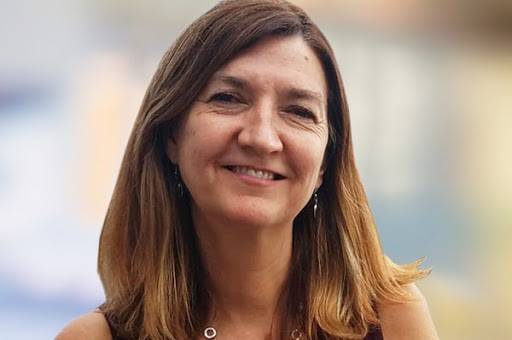
Researching Language Learning and Multilingualism: What's Social Justice Got to Do With it?
Our pandemic times continue to bring stress to our world through deterioration of solidarity for human diversity, a widening of economic inequalities, and the intensification of racial and religious conflict across the globe. Many multilinguals – even more so multilinguals in marginalized communities – are vulnerable in the present climate. Yet, disaffection for ethics, power, and ideologies has traditionally predominated the field of second language acquisition (SLA), which focuses on language learning by adults—people who learn a new language (formally or informally) during young, middle, or older adulthood, and therefore well outside primary socialization in the family. Should researchers who study adult language development, language learning, and multilingualism respond to these difficult times? If for some of us at least the answer is yes, then how can the field generate knowledge that can support social justice? I will propose several research strategies to respond to the needs that so many multilingual individuals, families, and communities are experiencing in our difficult times. I will also reflect on the barriers and possibilities for SLA scholars who wish to make their research useful for both elite and marginalized multilinguals.
February 10, 2022
Guest Lecture - Dr. Michał B. Paradowski, University of Warsaw
In person and virtual
LNCO Room 1110
3:30 - 4:30 pm MST (join 3:15 to socialize)
Language and Linguistics instruction during the pandemic:
What made some teachers and students cope better than others?
We examine the transition to emergency remote instruction during the COVID-19 pandemic based on questionnaire responses from over 6,000 language learners and teachers and Linguistics instructors and students from 118 countries. Among others, we identify the influence of the stage of education taught, mode of delivery, economic classification of the country, perception of student coping, anxiety about the future, living conditions, self-acceptance, appraisal of situational impact, course optionality, and perceived effectiveness of virtual delivery. Compared with in-person classes, teachers felt that remote instruction depressed students’ language progress by around 64%; the future learning outcomes were the biggest cause for concern in beginner-level classes. The breakup of some constructs in clusters of naturally correlating variables in turn suggests that in crisis situations these may function differently than during ‘business as usual’, supporting the Strong Situation Hypothesis. We also demonstrate stability in respondents’ lives and instruction correlated with their multilingualism.
*Note*: Further data analyses are in progress; by February we hope to offer new findings including the impact on coping of stakeholders’ personality traits.
February 17, 2022
Career Paths for Linguists - NSA and FBI
Virtual
3:30 - 5:00 pm MST
Join representatives from NSA (National Security Administration) and the FBI (Federal Bureau of Investigation) to discuss how your Linguistics degree can benefit you in these fields. They will discuss internship opportunities, employment options, and security clearance procedures. Linguistics can be used in both organizations as a tool in a variety of careers including analyst and translation positions.
February 24, 2022
Linguistics Colloquium Talk - Dr. Ryan Shosted, University of Illinois
Virtual
3:30 - 5:00 pm MST (join 3:15 to socialize)

Are there traces of the cord-card merger in Deseret Alphabet texts?
The merger /ɔ/ /ɑ/ before /r/ is widely-documented in Utah English, particularly along the Wasatch
Front.
The Deseret Alphabet was capable of rendering distinctions between pairs of back vowels
that have since
merged in Standard American and Utah English varieties. As a means of phonetically
rendering the distinction
between vowels that were perhaps already in the process of merging, Deseret Alphabet
texts composed in the
1860s may present some clues as to the development of the cord–card merger in Utah.
I present evidence from
the Deseret Alphabet printing of the Book of Mormon and the writings of Mormon diarist
Marion J. Shelton.
These writings indeed preserve transcriptional evidence of variable vowel quality
in pre-rhotic contexts,
suggestive of the merger. While this is not taken to be conclusive evidence of the
timing or diffusion of the
merger, it does provide positive evidence of variability relating to the merger.
March 24, 2022
Linguistics Colloquium Virtual Talk -Dr. Jessica Coon, McGill University
3:30 - 5:00 pm MST (join 3:15 to socialize)

Ergativity and extraction in Mayan languages
There are about thirty Mayan languages spoken today, and all of these languages exhibit morphological ergativity: in terms of their verbal agreement, intransitive subjects pattern with transitive objects (=absolutive), and differently from transitive subjects (=ergative). However, Mayan languages differ in whether this morphological pattern also has a syntactic effect. Mayan languages are verb-initial, and require elements to appear in a preverbal position for wh-questions, focus, and relativization (A’-extraction). While Mayan languages like Ch’ol freely permit the extraction of both ergative and absolutive arguments, other Mayan languages, like Chuj, restrict extraction: absolutive arguments freely extract, while ergatives arguments may not. This pattern of syntactic ergativity is known as the Ergative Extraction Constraint (EEC; Aissen 2017).
Building on recent work, I argue that the presence of absence of the EEC in Mayan languages is directly correlated with a major point of syntactic variation in the Mayan family: while objects in languages like Ch’ol remain low in the clause, objects in languages like Chuj consistently move to a position above the ergative subject, blocking the subject from extracting. I show how this single difference accounts for other points of variation between the two types of Mayan languages. More generally, I discuss how collaborative and comparative linguistic research on under-documented languages can contribute both to linguistic theory and to the goals of language communities
March 31, 2022
Career Paths for Linguists - DOs and DON’Ts of a CV for the Tech Industry
Virtual
3:15 - 5:00 pm MST
Linguists gain a lot of skills during their majors. But how do you craft a CV that looks appealing to an industry recruiter? What kind of skills are actually useful for a career in tech? What things you should absolutely NOT do when submitting a CV?
If these questions appeal to you, join us for a Q&A period with Dr. Alëna Aksënova (Linguist at Google)!
April 5, 2022
Undergraduate Research Symposium
In person and virtual
The Undergraduate Research Symposium provides an opportunity for University of Utah students to present their work in a scholarly setting to students, faculty and other members of the U community. Undergraduate students from all disciplines at the University of Utah are invited to present their research and creative work.
April 9-10, 2022
(F)ASAL-12 Conference
The (Formal) Approaches to South Asian Languages conference is the main venue in North America for discussion of theoretical and theory-driven research in South Asian linguistics.
April 15, 2022
University of Utah Student Conference in Linguistics (UUSCIL)
The University of Utah Student Conference in Linguistics provides an opportunity for undergraduate and graduate students to present their research in a scholarly setting to students, faculty, and other members of our Linguistics Community. The conference is intended to celebrate the wide breadth of issues taken up in theoretical and applied linguistics, including interdisciplinary approaches.
Thursday, Aug 25th
3:30pmVirtualWelcome (Back) to Linguistics!
Join us on Zoom passcode 564847 for a virtual social. The first 30 min will be dedicated to introducing new students to what the department has to offer. The last 30 min will be an opportunity for everyone to get to know each other.
Thursday, Sept 8th
5pmSugarhouse ParkDepartment Picnic
Sugar Beet Pavilion on the South East side of the park. UTA bus accessable from the Union on lines 21 (Bay C in front of the Union). Catering will be provided. Please join us with your friends and/or family!
Please RSVP by Sept. 2nd.

Thursday, Sept 22nd
Linguistics Colloquium – Dr. Shannon Barrios , University of Utah
3:30 - 5 pm LNCO 2110, Zoom will be available

The Social Weighting of Input Sources in Adult Lx Phonetic Learning
Input--the linguistic information available to language learners--is a necessary condition for language acquisition, whether native (L1) or subsequent (Lx). Infants make differential use of L1 input depending on social condition: they learn the phonetics of linguistic input through live-person interaction but not when it is presented by video or audio only (Conboy, Meltzoff and Kuhl 2015). Others have demonstrated that adult L2 learners are sensitive to the phonetics of L2 input, even in the absence of social interaction, leading to the question of whether adult L2 learners also “gate” their input such that some types will be more influential than others. The language classroom, where learners are exposed to phonetic input from an “authority” (the teacher) and also from fellow learners, provides an opportunity to explore the role that social dynamics play in the effects of input on L2 phonetic development. We conducted an experiment wherein English speakers heard auditory stimuli in an artificial language. During an exposure phase, in one condition the “teacher” produced tokens with 25 ms of VOT on initial segments and the students with 125 ms, and in another the VOT durations were reversed (in addition to control conditions where both students and teachers produced either long or short VOT). At test, participants judged as more target-like productions by a different speaker that matched the VOT durations of the teacher, but not the student, depending on their exposure condition, providing evidence for an influence of social factors in weighting input in L2 acquisition.
Thursday, Oct 6th
3:30pmVirtualApplying to Grad School

This virtual meeting will be hosted by Shannon Barrios, Aniellos De Santo, and Rachel Hayes-Harb and is intended for undergraduate students who are interested in learning more about graduate school application process. Undergraduates at any point in their careers are welcome and encouraged to join. Please register to receive the zoom link.
Thursday, Oct 20th
Linguistics Colloquium –Dr. Eihab Abu Rabiah, Visting Postdoctoral Scholar, University of Utah
3:30 - 5 pm LNCO 2110, Zoom will be available
Registration required
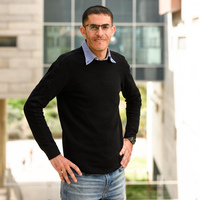
Vocabulary development of Hebrew as L2 to young Arabic learners
This presentation will cover my dissertation research in which I examined the vocabulary development of young learners who learn Hebrew as a second language in a longitudinal study. In the study, three lexical measures were examined: lexical diversity (the range of different words used in a text: total types / total tokens) (Jarvis, 2002, 2017; Yu, 2010), lexical density (the proportion of "content" or "lexical" words in a text) (Berman, 2008; Johansson, 2009), and lexical sophistication (the proportion of "sophisticated" or "advanced" words in a text) (Malvern et al., 2004; Lindqvist et al., 2011). Twenty-three high school students completed two assignments in grades 11 and 12: 1. writing an argumentative essay and 2. writing word meanings of 28 words (passive vocabulary) and creating a sentence for each word (active vocabulary). In the first assignment, lexical diversity and lexical density were tested, while lexical sophistication was tested in the second. Unlike previous studies in which these measures were tested similar to the English language, which differs in many respects from Hebrew, in this study the various measures were adapted to the lexical, syntactic, and orthographic characteristics of Hebrew. The findings demonstrate that the development in the three measures was not statistically significant, but statistically significant differences were found between the proposed methods and the previous methods. Moreover, it was found that as the lexical sophistication level of a word increased, students' accuracy (the number of correct answers) decreased and that with the increase in acquisition time, learners were better able to use their passive vocabulary more actively.
Thursday, Oct 27th
VirtualCareer Paths - Kenn Watts Foreign Service
3:30pm - 4:30pm Zoom

Learn about careers with the Foreign Service - from how to get started to language training to what it is like living with a family abroad. Kenn Watt joined the Foreign Service as a Management tracked officer in 2009. He has since served overseas in Nuevo Laredo, Mexico; Taipei; Beijing, China; and most recently as a General Services Officer in Tel Aviv, Israel. Kenn also served two years as an instructor of the General Services training course at the Foreign Service Institute in Arlington, Virginia. Kenn was born and raised in the Salt Lake City area and attended the University of Utah where he received a Master’s degree in Public Administration.
Thursday, Nov 17th
Dr. Karlos Arregi, University of Chicago
3:30pmVirtualColloquium
Registration Required
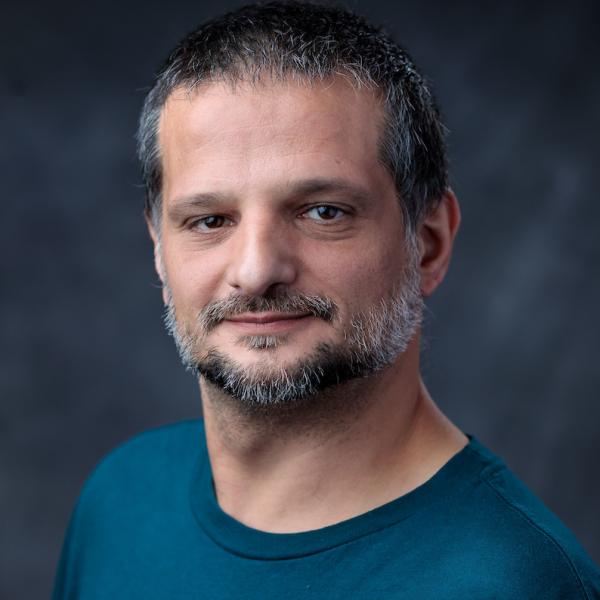
Head Movement as a Syntactic Operation
The theoretical status of head movement, illustrated by constructions such as subject-auxiliary inversion in English (e.g. Has the train arrived?), has been the subject of intense debate in the literature. One of the main points of contention is its relation to phrasal movement (relativization, passive, etc.) There are important differences between the two types of displacement, having to do both with the size of what's displaced (heads vs. phrases) and the locality conditions (head movement typically being subject to stricter locality conditions). The problem is compounded by the fact that head movement seems to violate certain hypothesized syntactic principles that phrasal movement has been claimed to follow, such as the Extension Condition. The response to this complex empirical picture has been varied. Some have argued that head movement is the same type of operation as phrasal movement (i.e. Move/Internal Merge; i.a. Roberts 2010, Preminger 2019), others, that it is not and should be an operation that applies in the postsyntactic component (PF; i.a. Harizanov & Gribanova 2020, Hein 2020), and yet others have claimed that what appears to be displacement of heads is in fact displacement of phrases (Koopman & Szabolcsi 2000, Myler 2017).
In recent work, Asia Pietraszko and I hypothesize that head movement is a syntactic operation that is distinct from phrasal movement (i.e. it's not Move/Internal Merge). In this talk, I discuss two related arguments for this view. The first is based on the properties of long verb movement in Breton, and in particular, how it affects the realization of verbs and verbal inflection. These properties show that long verb movement behaves like phrasal movement, and not like the type of head movement discussed above. What this investigation reveals then is that while long verb movement (more generally, long head movement) should be unified with phrasal movement, head movement should be kept as a distinct operation. The second argument has to do with remnant movement interactions, namely, constructions in which displacement of x out of phrase y is followed by phrasal movement of the containing phrase y to a higher position. The generalization, amply documented in the literature, is that x is pronounced only once (in its derived position) if its displacement is the result of phrasal movement, but twice (in both its base and derived positions) if its displacement is the result of head movement. Taken together, the facts provide a strong argument for the distinctness of head movement as a syntactic operation in its own right.
Thursday, Dec 1st3:30pmLNCO 2110Honors meeting- students pursuing honors thesis in linguistics
Thursday, Dec 8th
10am-5pm LNCO 2300 Study Break Game Day

You've made it to the last day of classes! Need a study break? Come play games with us and meet the new Academic Advisor! Food and games provided. Stop by the main office anytime between your classes.
Tuesday, Dec 13th
1-4pm LNCO 2110 Karen Marsh Schaeffer Open House
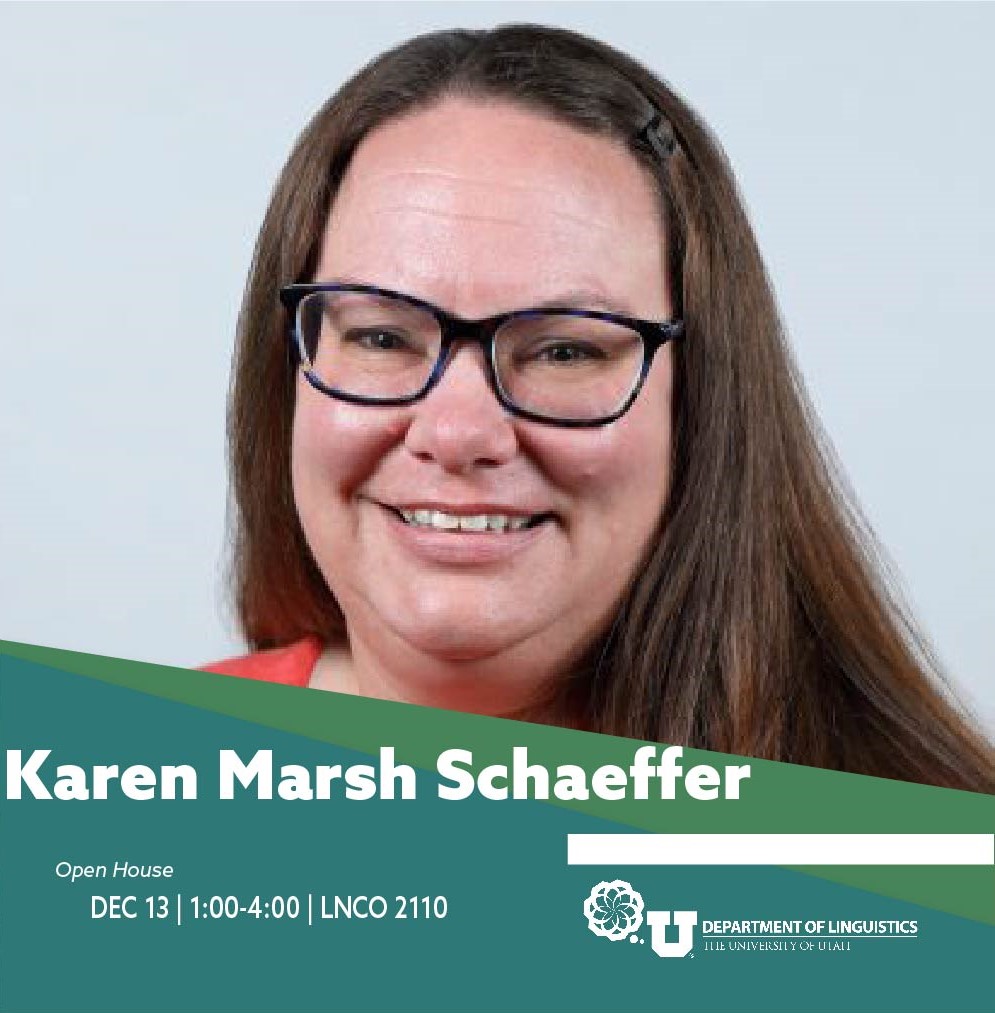
We’d like to offer our many thanks and to congratulate our amazing Student Support Specialist, Karen Marsh Schaeffer, on her new adventure with the College of Humanities as the Director of Student Success and Engagement. Karen has been in the Linguistics department for roughly 15 years. Not only has she spent the majority of her career here, but she completed her bachelor’s and master’s degree in our department. She will direct and oversee operations and strategic planning of student service functions and will act as the liaison for departments, faculty, staff, students and external entities to ensure continuity and quality of student services. After the transition period Karen’s office will be located in the new Humanities Student Success Center (opening in CTIHB in 2023).
Join us for an open house celebration.
2021
 January 28, 2021
January 28, 2021
Linguistics Colloquium Talk - Dr. Anna Krulatz, Norwegian University of Science and Technology, Professor
Using the DLC Framework to Examine Linguistic Identities of Transnational Multilinguals
A marked increase in international mobility, including forced relocation and voluntary migration, has resulted in a notable growth in the number of transnational individuals who have crossed “cultural, ideological, linguistic, and geopolitical borders and boundaries of all types” (Duff, 2015, p. 57). Modern societies are thus characterized by an unprecedented ethnic, cultural, and linguistic superdiversity, leading to new ways in which identities are constructed, experienced, and communicated (de Fina & Perrino, 2013). Experiences associated with moving to a new country and adding another language to one’s linguistic repertoire can cause shifts and changes in the way multilingual individuals define and perceive themselves. As transnational multilinguals grapple with questions of identity and belonging, the straightforward, one-to-one correspondence between identity, language, ethnicity and/or place of origin can no longer be taken for granted. In this paper, I examine identity of transnational multilinguals through a novel lens, namely Dominant Language Constellation (DLC) (Aronin, 2016; Aronin & Ó Laoire, 2004; Aronin & Singleton, 2012), which allows for an inclusion of psychosocial factors such as a person’s cognitive abilities, attitudes, emotions, educational profile, and cultural and ethnic origins, thus expanding the study of individual multilingualism beyond a strictly language-related framework. The data sample consists of ten personal narratives, language background questionnaires, and DLCs drawn by the participating transnational multilinguals. In the analysis, I examine the following a-priori themes: (1) complexity and variation within DLCs of transnational multilinguals; (2) effects of migration on language trajectories; (3) transnational multilinguals’ identity constructions; and (4) the role and status of English in DLCs of the participants. The study illustrates the intricate relationships between transnational multilinguals’ cultural and linguistic roots, their lived experiences, and language ideologies in how they construct their multilingual self-image.
February 11, 2021
Building Resumes and Cover Letters
Join Megan Randall, Career Coach with the Career and Professional Development Center, University of Utah, and learn how to create eye catching resumes and cover letters.
In this workshop, you will learn:
- Explain basic formatting guidelines for resume writing
- Tailor a resume to the opportunity and audience
- Write accomplishment statements for transferable skills
- Indicate the basic structure for formatting a cover letter
- Articulate a specific reason for their interest in the position
- Identify top strengths (skills, knowledge, experience) which demonstrate fit for the particular position
 February 25, 2021
February 25, 2021
Linguistics Colloquium Talk - Dr. Ariel James, Macalester College, Assistant Professor of Psychology
Individual Differences in Syntactic Processing: A psycholinguist's "two-disciplines" problem
There remains little consensus about whether there exist meaningful individual differences in syntactic processing and, if so, what explains them. In this talk, we will describe a study that we completed with our colleagues in which we replicated three major syntactic phenomena in the psycholinguistic literature: use of verb distributional statistics, difficulty of object- versus subject-extracted relative clauses, and resolution of relative clause attachment ambiguities. We examined whether any individual differences in these phenomena could be predicted by language experience or general cognitive abilities (phonological ability, verbal working memory capacity, inhibitory control, perceptual speed). We found correlations between individual differences and offline, but not online, syntactic phenomena. Condition effects on reading time were not consistent within individuals, limiting their ability to correlate with other measures. We will discuss these findings in the context of Cronbach's "two disciplines" problem of combining experimental and correlational approaches.
March 4, 2021
Linguistics CareerPath Event
Time:3:15 - 5:00pm | Location: Virtual and recording available
Join us for virtual return visit from University of Utah alum Andrew Zupon, Eve Olson, and Rebecca Rivas. Learn how these three have leveraged their linguistics training, research experiences, internships, as they pursue their respective careers in Linguistics.
 Andrew completed both his HBA and MA at the University of Utah and is currently pursuing
a PhD in Linguistics at the University of Arizona. After completing his MA, Andrew
worked as a contractor at Google. While pursuing his PhD, Andrew has done two summer
internships (Chatbot Intern, Nextiva and Linguist Intern, Google), along with some
other computational work at the university.
Andrew completed both his HBA and MA at the University of Utah and is currently pursuing
a PhD in Linguistics at the University of Arizona. After completing his MA, Andrew
worked as a contractor at Google. While pursuing his PhD, Andrew has done two summer
internships (Chatbot Intern, Nextiva and Linguist Intern, Google), along with some
other computational work at the university.
 Eve Olson graduated with a HBA in Linguistics from the University of Utah and earned
her MA in Translation from Kent State University. Following her MA she completed an
internship at the UN in Austria. Eve is currently doing freelance translation and
editing with the ultimate goal attaining a translation job with the government.
Eve Olson graduated with a HBA in Linguistics from the University of Utah and earned
her MA in Translation from Kent State University. Following her MA she completed an
internship at the UN in Austria. Eve is currently doing freelance translation and
editing with the ultimate goal attaining a translation job with the government.
 Rebecca Rivas completed her BA in Linguistics just this past Fall and has already
begun working for LingoTek! Learn about the work she is doing with this local translation
company, how she leveraged her coursework and other experiences as an undergraduate
and connected with them so quickly
Rebecca Rivas completed her BA in Linguistics just this past Fall and has already
begun working for LingoTek! Learn about the work she is doing with this local translation
company, how she leveraged her coursework and other experiences as an undergraduate
and connected with them so quickly
READ AND DOWNLOAD A FULL ARTICLE ON THIS TOPIC
 March 25, 2021
March 25, 2021
Linguistics Colloquium Talk - Dr. Alayo Tripp, University of Minnesota, Postdoctoral Associate in Speech-Language-Hearing Sciences
Time: 3:30 - 5:00pm | Location: Virtual only (Join at 3:15 to socialize)
Infants represent differences between groups of talkers, and use this information to guide their social preferences. Nevertheless, models of word learning often abstract away from social information. The omission of social information from these models makes them unable to capture the way that children select which linguistic data to learn from based on their social and cultural experiences. In this talk I review two previous infant word learning experiments and show that their results can be better predicted by a model which incorporates infants’ beliefs about the relative value of informants.
April 6, 2021
Undergraduate Research Symposium
April 9, 2021
University of Utah Student Conference in Linguistics (UUSCIL)
We are pleased to announce that the University of Utah Student Conference in Linguistics (UUSCIL) 2021 will take place virtually on Friday, April 9th 2021 on our Department Canvas page. As usual, the conference provides an opportunity for our students to present their research in a scholarly setting to students, faculty and other members of our Linguistics community. All presentations will be given as poster presentations.
Undergraduate students who chose to present at UUSCIL are also strongly encouraged to present their work at the Undergraduate Research Symposium on April 6th. The URS is a campus wide event. As such, it offers an unprecedented opportunity for students to present their Linguistic research to a broader (non-specialized) audience.
University of Utah Linguistics undergraduates and graduate students interested in presenting their work will need to register by March 26th, 2021.
April 16, 2021
Forum on Language and the Law
Time: 9:00 am - 12:00 pm
The theme for the 2021 Forum on Language and the Law is legal interpretation, and this includes an emphasis on corpus linguistic methods for determining original and ordinary meaning in statutes, contracts, trademark agreements, the Constitution, and other important documents. The speakers at the 2020 Forum include two linguists, a law professor, and a Utah Supreme Court Justice. The first linguist, Jesse Egbert (Northern Arizona University), will offer insights into best practices in corpus-based linguistic research dealing with questions of original and ordinary meaning. The law professor, Lawrence Solum (Georgetown University), will discuss original and ordinary meaning from a legal perspective, focusing particularly on constitutional law. The second linguist, Tammy Gales (Hofstra University), will highlight linguistic principles and methods while emphasizing her work on statutory interpretation in trademark cases. Finally, Associate Chief Justice Tom Lee (Utah Supreme Court) will discuss the empirical methods he has used and advocated for when dealing with questions of legal interpretation.
The information and methods presented in this symposium will help lawyers, linguists, and judges improve their abilities to analyze and evaluate linguistic evidence related to legal interpretation in multiple domains of civil and criminal law.
August 26, 2021
Welcome (back) to Linguistics
The Department would like to welcome all to attend the Welcome (back) to Linguistics Virtual Event.
Undergraduates, please join us virtually at 3:30, if you can, for a brief information session hosted by Shannon Barrios, the Department of Linguistics Director of Undergraduate Studies. The session will be aimed at undergraduate students, especially those who are new to our community (we can't wait to meet you!), and will include details about departmental communication, department events, and other opportunities for rich experiences available to undergraduates students (internships, research, and club participation), as well as resources and support
Graduate students, Faculty, Instructors, Staff, and friends of Linguistics, please join at 4 pm for an opportunity to meet new faces and connect virtually with familiar ones.
September 16, 2021
Linguistics Colloquium Virtual Talk - Dr. Joseph Farquharson, University of the West Indies, Mona
3:30 - 5:00 pm MST (join 3:15 to socialize)

Reconstructing Akan Day-names: Supporting Evidence from the Caribbean
Jamaican Creole and several other Atlantic English Creoles (AECs) share a set of day-names with Ákàn and several other geographically contiguous Kwa languages. The day-names, based on a seven-day week, are typically assigned to a baby based on the day of its birth and its biological sex. The day-name systems found in Jamaican Creole and several of the AECs are striking in that they have fewer gaps than the modern Kwa languages (other than Ákàn), and exhibit far greater similarity than the Kwa systems. These facts are taken as an indication that the systems in the other Kwa languages were borrowed from the Ákàn system (and hence are not cognate with it), and are potentially more recent than the Caribbean systems. In fact, the Caribbean side more than likely reflects a single system that was established in one territory, that was later diffused to other territories. Additionally, not only is the Caribbean system older than the non- Ákàn systems, it also appears to be cognate with the Ákàn system. This conclusion is based on a reconstruction of the Ákàn proto-system using the comparative method, as well as information on the diachronic lexicology of Ákàn. The talk will present the method used for the reconstruction, and then discuss the findings in light of the sociolinguistics of diaspora.
September 23, 2021
Community Read and Discussion, 3:30 PM, MST
We are excited to announce a community read and discussion for the Department of Linguistics as part of on-going equity, diversity, and inclusion (EDI) efforts (Please see the Department of Linguistics antiracism and diversity and inclusion statements here.) For this community activity, we have chosen the book From Equity Talk to Equity Walk (2020) by Tia Brown McNair, Estela Mara Bensimon, and Lindsey Malcom-Piqueux. All members of the department community are invited to participate.
Our community read discussion will take place virtually in Zoom on Thursday, September 23, 2021 at 3:30pm:
For undergraduate students, we have a special incentive: The first 20 to respond will receive a complimentary copy of the book. Sign up for your free copy of the book here: We will contact you when we have the books available in the department for pick up.
This book is also available electronically through the Marriott Library. You will need to login with your university ID and then you can either view or download (for 100 days). Click here for library access.
As we are reading, feel free to join in (or start) discussions about the book on our department teams channel. Everyone in the department should be on our Microsoft teams account. You can learn how to activate it on your device here.
We hope you will join us for this community read to listen and learn, to share your thoughts, and to help us strengthen our antiracism and EDI efforts.
October 21, 2021
Applying to Graduate School Virtual Event, 3:30 - 5:00 pm (join 3:15 to socialize)
This virtual meeting will be hosted by Shannon Barrios, Aniellos De Santo, and Rachel Hayes-Harb and is intended for undergraduate students who are interested in learning more about graduate school application process. Undergraduates at any point in their careers are welcome and encouraged to join.
October 28, 2021
Linguistics Colloquium Talk - Dr. Joey Stanley, Brigham Young University
3:30 - 5:00 pm MST (join 3:15 to socialize)
2110 LNCO (will also be available to watch via zoom)
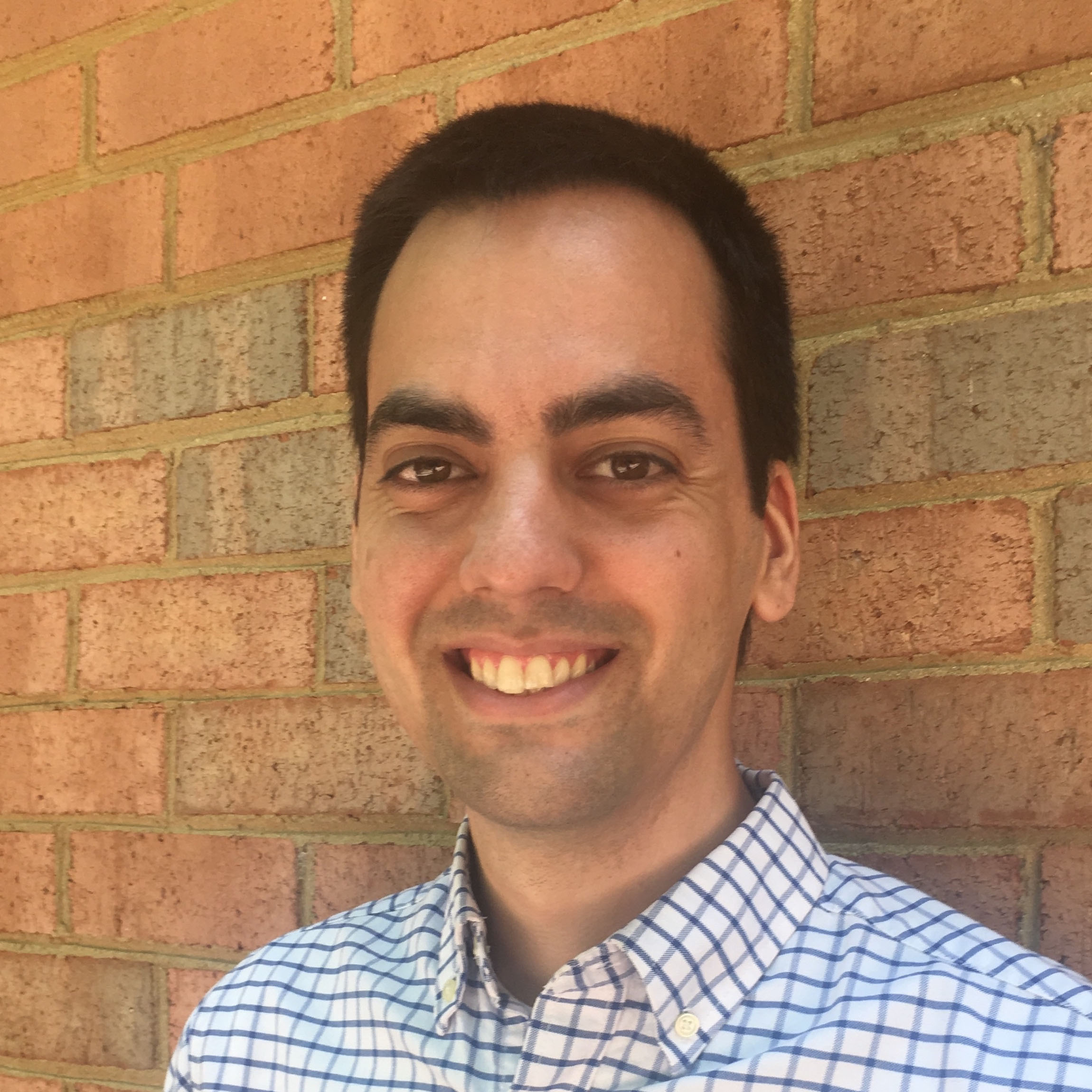
What can vowel formant trajectories tell us about language change?
Most descriptions of English vowels are based on acoustic measurements taken at their midpoint. However, there are more to vowels than their midpoints. Advances in computational power and statistical modeling have made robust analyses of vowel trajectories now possible and sociophoneticians can now ask questions that, until recently, were impossible to answer. I present three case studies on vowel trajectories and their change over time. Front lax vowels in Washington reveal that changes in trajectory can accompany vowel shifts. However, back vowels in the American South show that vowel shifting does not imply changes in trajectory. Finally, prelateral vowels in Utah can enrich our understanding of vowel merger. These examples illustrate that as more studies incorporate vowel trajectories, we can greatly expand our descriptive, theoretical, and sociolinguistic understanding of language, even on vowels canonically considered monophthongs.
November 18, 2021
Linguistics Colloquium Virtual Talk - Dr. Claire Moore-Cantwell, UCLA
3:30 - 5:00 pm MST (join 3:15 to socialize)
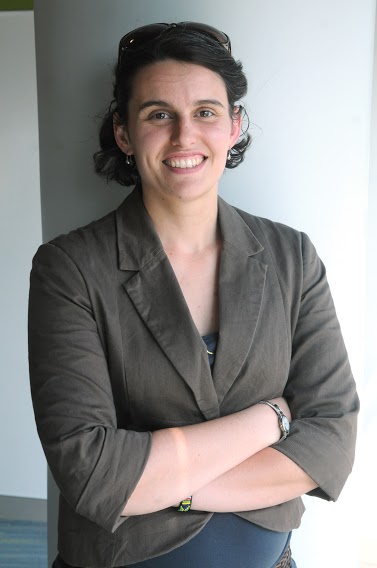
Lexical idiosyncrasy and experience: A grammatical-lexical model
This talk presents some predictions of Representational Strength Theory (RST), a constraint-based
model incorporating both grammatical and lexical factors. In RST, traditional faithfulness
constraints are replaces by Phonological Form Constraints (PFC's), which
encode lexicalized properties of a word. The key prediction of this model is that
probabilistic grammar can be learned alongside lexically
specific behavior of individual words. The talk will focus on the effects of lexical
frequency: Empirically, the more experience a learner
has with a particular lexical item, the more that lexical item may diverge from the
phonological grammar, and the more rigid its behavior
is (Morgan and Levy 2016, Smith and Moore-Cantwell 2017). Iterated learning simulations
demonstrate that this behavior is predicted by RST, but not by competitor models,
such as a Faithfulness to listed exceptions, lexically-indexed constraints, or cophonologies.
2020
September 3, 2020
Getting to Know Aniello de Santo - Our Newest Faculty Member
Time: 3:30 - 5:00pm | Location: Virtual through Zoom (Join at 3:15 to socialize)
We are very excited to welcome Aniello to the department. Here is an opportunity to get to know him better. Our host is Shannon Barrios, Director of Undergraduate studies in Linguistics.
September 17, 2020
Linguistics Colloquium Talk - Brett J. Hashimoto, Brigham Young University, Linguistics Assistant Professor
New Methodological Approaches in Describing Proportional Language Experience
The purpose of this colloquium is to describe new approaches for describing the typical language experience of a group of people. More specifically, it will cover two studies whose purpose was to examine the English language experience of students (i.e., language input, output, and interaction) at an American university.
The first study described university students’ language experience situationally using a new approach that combines diary and survey methods. Fifty-three university students were recruited to document their language experience for a minimum of a four-hour period. First, they logged all of their language in a logbook/diary. Then, referencing their logbooks, they filled out a survey for each logbook entry detailing the register and other situational information about the language that was experienced. The typical language experience of university students was then characterized using descriptive statistics of the proportions of language experience within the sample of students.
The results from the analyses of the survey data revealed that university students are using a wide range of registers in both interesting and unexpected ways. For example, university students reported using 37 distinct registers with face-to-face conversations being the most used, making up 12% of students’ language experience on average. The results of the surveys also showed that university students’ most common processing mode was listening at 49% of their language experience (more than double any other mode with reading = 21%, writing = 18%, speaking = 12%). They also found that 64% of university student language experience is non-interactive.
The second study described students’ written language experience linguistically and functionally. For the sake of feasibility, spoken language was excluded from the corpus analysis.
A written corpus of typical university students’ language experience was developed by gathering all of the written language that university students experienced over a given period of time. The written language collected from participants was converted into the Proportional American University Student Experience (PAUSE) Corpus, which consists of 580 texts totaling in 405,954 word tokens and spanning 21 registers. The corpus data was annotated with linguistic features from the Biber Tagger. The data was then analyzed by calculating the mean dimension scores for each register based on Biber’s (1988) multidimensional analysis and mapping registers onto the first five dimensions from that analysis.
Based on the corpus analysis, it was found that university student written language experience was characterized by high rates of features used to convey information densely and that were used for non-narrative purposes and low rates of features used for persuasion. Using this method, prose-light registers were analyzed and found to be neither phrasally nor clausally complex.
In summary, these studies shed light onto the nature of how university students are experiencing language on a day-to-day basis. This type of information is useful for EAP professionals and learners who seek to understand the language of the university students. This research also develops new approaches to describe the typical language experience of a group of people that has potential for application in many areas.
October 8, 2020
How to Apply for Graduate School
Time: 3:30 - 5:00pm | Location: Virtual only (Join at 3:15 to socialize)
Join Rachel Hayes-Harb and Shannon Barrios to learn what is needed and tips and tricks to apply to graduate school. Plenty of opportunity to ask questions and get it all figured out.
October 15, 2020
Dealing with Stress and Anxiety in these Uncertain Times
Time: 3:30 - 5:00pm | Location: Virtual only (Join at 3:15 to socialize)
University of Utah Counseling Center and Wellness Center will talk with students about how to cope with life in this ever-changing situation. If you are looking for a little reassurance and tips for how to make it through the semester, this is for you. There are lots of resources around campus that can help and we want you to be aware of those.
October 29, 2020
Linguistics Colloquium Talk - Dr. David Beard, University of Maryland, Baltimore County, Assistant Professor
Time: 3:30 - 5:00pm | Location: Virtual and recording available (Join at 3:15 to socialize)
I know Spanish. Which romance language should I learn next?: L2 Influence on L3 Word Recognition
The present study addresses historical and contemporary discussions on second and third language vocabulary development, specifically the effects of lexical similarity. Second language learners of Spanish aspiring to learn another romance language completed a translation recognition task with Spanish as the source language and Portuguese or Italian as the target language. Cognate and non-cognate targets were used. Reaction times were modeled as a function of language and word type using a linear mixed-effects model with subject and item serving as random effects. Results show that there is no significant processing advantage in recognizing words in Italian or Portuguese. With respect to word type, cognates were responded to significantly faster than non-cognates. These results speak to historical and contemporary accounts of lexical similarity in that Spanish and Italian are rated at 82% and Spanish and Portuguese at 89%. Implications speak to both language researchers and educators.
Keywords: second language acquisition, third language acquisition, vocabulary, cognate facilitation effect, lexical similarity measures, edit distances
READ AND DOWNLOAD A FULL ARTICLE ON THIS TOPIC
Thursday, November 5, 2020
How to Land the Perfect Internship
Time: 3:30 - 5:00pm | Location: Virtual only (Join at 3:15 to socialize)
Join Humanities internship coordinator, Ned Khatrichettri, and learn how to find and apply for internships. During the pandemic is the perfect time to look at setting up an internship for Spring or Summer. We are excited to help you find and land the perfect internship.
Thursday, November 12, 2020
Linguistics Colloquium Talk - Dr. Donald Rubin, University of Georgia, Emeritus Faculty and Dr. Okim Kang, Northern Arizona University, Professor
3:30 - 5:00pm | Virtual and recording available (Join at 3:15 to socialize)
5:00 - 6:00pm | Students can join Dr. Rubin and Dr. Kang for an informal questions/socializing event
Accent is (at Least Partly) in the Ear of the Beholder: Effects of Listener Exepectations on Perceptions of Accented Speech
Normal speech perception is a constructivist process in the sense that the listener fills in a great deal of information that is not actually present in the acoustic signal. It is not surprising, therefore, to discover that perceptions of a speaker’s pronunciation and consequent judgments of oral performance are highly susceptible to the listener’s expectations about how that speaker will sound. If extraneous information leads listeners to expect to hear a speaker with a marked non-native accent, then their speech perceptions are likely to manifest distortion in that direction. This phenomenon—known as reverse linguistic stereotyping (RLS)--is confirmed by 25 years of empirical study. Recent research on effects of listener background on judgments of speaker accent are likewise consistent with the concept of RLS. In the presentation, we will start with descriptions of evidence for RLS and explain the effects of various listeners’ expectations on social judgements including examples from both academic and other high stakes contexts. We conclude with a discussion of some ways in which various branches of linguistics can help build a more just and equitable society.
If you would like to receive announcements about our events, please email linguistics@utah.edu and ask to be added to the ling-announcements listserve.
2019
January 24, 2019
North American Computational Linguistics Olympiad for high school students
Open Round: January 24, 2019
Time: 10:00am - 1:00pm (Please arrive early as the contest starts immediately at 10:00am)
Location: University of Utah Language & Communication building (LNCO) Room 2110
Address: 255 S. Central Campus Drive, Ste 2110 Salt Lake City, UT 84112
The University of Utah is a local host for the North American Computational Linguistics Olympiad! NACLO is a free contest in which high school students learn about linguistics and language technologies by solving puzzles. The contest helps students identify potential careers related to languages and language technologies. They also exercise problem-solving skills and have fun!
We will be hosting practice rounds on November 14th and December 4th at 3:30pm-5:00PM in room 2110 of the LNCO building (same room as the open round competition) Please join us if you’d like to get familiar with the types of problems you may encounter during the competition rounds.
Registration is open now! To register, please follow this link and list the University of Utah as your Site.
For questions, information, and practice problems, please visit http://nacloweb.org/.
February 21st, 2019
Colloquium: Sean Redmond
LNCO 2110, 3:30PM
Abstract: Sean Redmond received his B.A. in Speech and Hearing Sciences from the University of California, Santa Barbara in 1990, his M.A. in Speech Language Pathology from the University of Kansas in 1993, and his Ph.D. in Child Language from the University of Kansas in 1997. He teaches and conducts research in the Department of Communication Sciences and Disorders at the University of Utah on language development, assessment and intervention and presents his work regularly at national and international conferences. Dr. Redmond has several peer-reviewed publications as well as book chapters on these topics. His scholarship has been funded by the National Institutes of Health. He has also served as associate editor for the Journal of Speech, Language and Hearing Research, and Language, Speech, and Hearing Services in Schools. Sean Redmond was born in Omaha, Nebraska but spent/misspent his formative years in southern California.
March 7th, 2019
Colloquium: Hyeonjeong Jeong
LNCO 2110, 3:30PM
"In this talk, I provide three exemplary studies that combine the cognitive neuroscience with various fields such as linguistics, psychology, and education. The first example is a series of studies I conducted from a linguistics perspective (e.g., Jeong et al., 2007; Hsieh, Jeong et al., 2017). I examined how linguistic similarities and differences between first language and second language influence brain activation. The second example is a series of empirical studies conducted from a psychological perspective (e.g., Jeong et al., 2010, 2016). I investigated the extent to which cognition (i.e., memory) and affect (i.e., anxiety) determine brain mechanisms during language processing and acquisition. The third piece of research is a study I conducted with a team of educational researchers (e.g., Jeong et al., 2011). I was interested in how the mode of communication (i.e., face-to-face vs. computer-mediated) influences brain mechanisms during second language communication. Through this talk, I hope to demonstrate that interdisciplinary collaboration among neuroscientists, linguists, and psychologists can contribute to a deeper understanding of second language acquisition."
March 28th, 2019
Colloquium: Wing Yee Chow
LNCO 2110, 3:30PM
"Much research has shown that comprehenders can generate predictions about upcoming language on the fly, but less is known about (i) what cognitive processes are engaged when we encounter cues that are inconsistent with our predictions, and (ii) how the working memory demands associated with predictive processing might interact with our parsing decisions. In the first part of the talk I will present a project in Mandarin Chinese which examine whether and how comprehenders may revise their predictions on the fly. I will present convergent findings from a visual world eye-tracking study and an event-related potential (ERP) experiment which suggest that comprehenders can quickly revise their existing predictions upon encountering a cue that is inconsistent with their existing predictions. In the second part of the talk I will discuss two reading eye-tracking experiments in English that investigate when comprehenders posit a dependency between two non-adjacent elements in a sentence (e.g., between a verb and its subject/object) and how the working memory demands associated with prediction may impact their parsing decisions."
April 18th, 2019
Colloquium: Johanna Watzinger-Tharp
LNCO 2110, 3:30 PM
Johanna Watzinger-Tharp is an Associate Professor in the Department of Linguistics at the University of Utah. She served as Associate Dean for International Programs in the College of Humanities from 2009-2015, and directed the U’s International Studies Program from 2009-2016. Her research focuses on language pedagogy, dual language immersion and teacher education, and has been published in a variety of scholarly journals. She currently serves as co-editor for Issues in Language Program Direction. Her publications also include co-edited volumes and German language textbooks. In 2010, the American Council for the Teaching of Foreign Languages (ACTFL) awarded her the Anthony Papalia Award for Excellence in Teacher Education.
September 19th, 2019
Linguistics Colloquium Talk - Dr. Adrienne Lehrer, Professor Emerita University of Arizona
LNCO 2110 3:30 PM - 5:00 PM
Lexical Blends and other Trendy Neologisms
"Although blends like ‘brunch’ have been around for a long time, they have been becoming increasingly popular, so much so that they should be considered a fully productive part of word formation in English. Besides illustrating blends and similar neologism, I will discuss some of my experimental work on processing these words."
September 26th, 2019
Linguistics Colloquium Talk - Seung Kyun Kim - PhD in phonetics & Speech Perception from Stanford University
LNCO 2110 3:30 PM - 5:00 PM
Effects of social information on speech perception
The focus of work on speech perception has been mostly on the mapping of the variable phonetic signal to stable sounds and words, with much less focus on the role of rich social information available to listeners during that process. In this talk, I will discuss two types of social information that crucially modulate speech perception. First, there is rich speech-internal social information such as the speaker’s age, gender, emotional state that listeners infer from the speaker’s voice. I will present several cross-modal priming studies that show how speech-internal emotional information (i.e., emotional prosody) influences the spoken word recognition process in systematic but complex ways. Second, there is equally rich speech-external social information including all the visual cues about the speaker and the surroundings that listeners receive during speech processing. I will present a perceptual learning study and show that phonetic recalibration is influenced by facial expressions of the picture presented with the speech signal. Throughout the talk I will argue for the crucial and essential role of social information in spoken language processing. I will also suggest one of the most important roles of social information is to allocate different degrees of attention to the speech signal, which has consequences for reevaluating models of speech perception that do not embrace the social nature of human language.
October 17th, 2019
Linguistics Colloquium Talk - Chisato Kojima, Assistant Professor, University of Utah
LNCO 2110 3:30 PM - 5:00 PM
Lexical encoding of length contrasts in learners of Japanese as a second language
"Some contrasts in the second language (L2) impose difficulty in processing for learners, especially when these contrasts are not used phonemically in a learner’s first language (L1). This talk is to examine how American English speakers learning Japanese discriminate and store information regarding the L2 contrasts as a part of their lexicon (i.e. lexical encoding).
The central discussion is on how length contrasts, both consonantal and vocalic (e.g. shita “under”, shitta “came to know” and shiita “theta”) are perceived and processed by learners. In addition, a relationship between geminate and long vowel were examined (e.g. shitta “came to know” and shiita “theta”). Three experiments were conducted to test the learner’s ability to discriminate and lexically encode (a) singleton vs. geminate consonant, (b) short vs. long vowel, and (c) geminate and long vowel.
The first experiment was a discrimination task (ABX) to see whether learners can discriminate between these contrasts. The other two tasks were lexical decision and forced lexical choice (FLeC). These tasks implicitly require full lexical processing. The FLeC task is an innovative experimental paradigm that was introduced in Kojima (2019) in order to supplement the lexical decision task. The results from the ABX and lexical decision tasks indicated that there is a distinction between discriminating length contrasts and successfully encoding length contrasts as a part of Japanese words."
November 14th, 2019
Linguistics Colloquium Talk - Miquel Simonet, University of Arizona
LNCO 2110 3:30 PM - 5:00 PM
The Problem with Stress, Lexical Stress
One aspect of the Spanish language that seems to present significant difficulties to second-language (L2) learners whose first language (L1) is English concerns lexical stress. In Spanish, lexical stress is the contrastive phonological feature distinguishing words such as caso [ˈkaso] ‘case’ and casó [kaˈso] ‘s/he married’ or bebe [ˈbeβe] ‘s/he drinks’ and bebé [beˈβe] ‘baby.’ Spanish and English differ in the lexical distribution patterns of stress and in the phonetic correlates of this phonological features, but stress is contrastive in both languages. Transfer from the L1 is known to be a major determinant of the phonological obstacles encountered in the L2 acquisition process, which would suggest, as a first hypothesis, that English speakers’ difficulties with Spanish lexical stress could be a result of some type of cross-linguistic influence. But, since stress is contrastive in both languages, what (exactly) is the obstacle?
The present study explores one aspect of the difficulties native English speakers face when learning Spanish lexical stress, weak phonological encoding capacities pertaining to stress. We demonstrate that one of the reasons why native English speakers find acquiring lexical stress challenging is that lexical stress is not available during phonological encoding for this population, perhaps because native English speakers do not include stress features in their L1 lexicon and must learn to do so in the L2.
In this study, we report on the results of three perceptual-processing experiments with nonwords differing in their stress configuration: an AX discrimination task, an ABX categorical discrimination task, and a sequence-recall task with four auditory stimuli per trial. Participants were approximately 100 L2 learners of Spanish with English as their native language and a small group of native Spanish speakers to serve as controls. Learners differed in their experience with Spanish and their proficiency in the language, and complementary data were obtained by means of a vocabulary-size test, a cloze-test, and a bilingual-profile questionnaire. The results of the three experiments show that learners find processing stress differences in nonwords to be very challenging, but also that some improvement is possible with increased experience with their L2.
We hypothesize that native English speakers who are learning Spanish as their L2 find Spanish lexical stress patterns difficult to acquire because, at the initial stages of their learning, they possess a phonological system with restricted phonological encoding capacities for stress. In other words, these learners lack detailed phonological representations of stress in their native language, which entails that, during phonological encoding, they are not able to access such representations. This presents an obstacle in their acquisition of Spanish because they must learn to retain stress information in their mental representation of Spanish word forms. Current theoretical frameworks proposed to explain the phonological encoding of stress categories across language experiences, such as those proposed in Altman (2006) and Peperkamp et al. (2010), cannot truly account for the data reported in the present study and must be slightly modified to do so.
References
November 21, 2019
Linguistics Colloquium Talk - Adrian Palmer, University of Utah
Daniel Dixon, Northern Arizona University
MaryAnn Christison, University of Utah
Tülay Örücü Dixon, Northern Arizona University
LNCO 2110 3:30 PM - 5:00 PM
Justifying the Design, Development, and Use of Research in Applied Linguistics
"Argumentation theory is the interdisciplinary study of how conclusions can be reached through logical reasoning. One of the most influential theories of argumentation in current use is the structure proposed by Toulmin (2003) consisting of six components—claims, data, warrants, backing, rebuttals, and inferential links. In Toulmin’s argument structure, these components unfold to highlight the strengths and weaknesses of the argument. In our presentation, we advance this idea by presenting a fully developed research use argument (RUA) complete with claims, warrants, backing, rebuttals, and inferential links. The RUA is presented using a newly developed Python-based software application
The RUA and the software application make important contributions to furthering research in applied linguistics as the RUA supports new researchers and their mentors by providing logical and clearly defined components of the argument structure, as well as the structure of supporting documentation. In addition, the software application addresses concerns related to replication research (Ellis, 2019) by guiding users to supply specific data necessary for replication."
2018
January 25, 2018
North American Computational Linguistics Olympiad for high school students
Open Round: January 25, 2018
Time: 10:00am - 1:00pm
Location: University of Utah Language & Communication building (LNCO) Room 2110
Address: 255 S. Central Campus Drive, Ste 2110
Salt Lake City, UT 84112
The University of Utah is a local host for NACLO! NACLO is a contest in which high school students learn about linguistics and language technologies by solving puzzles. The contest helps students identify potential careers related to languages and language technologies. They also exercise problem-solving skills and have fun!
Registration is open now! To register, please follow this link and list the University of Utah as your Site:
For questions, information, and practice problems, please visit http://nacloweb.org/.
February 8th, 2018
Colloquium: Brennan Payne, "As far as the eye can see: Event-related brain potentials
reveal dynamics of visual attention allocation during sentence processing"
LNCO 2110, 3:30PM
"As far as the eye can see: Event-related brain potentials reveal dynamics of visual
attention allocation during sentence processing.”
Skilled readers obtain information not only from the currently fixated word, but also
from words in parafoveal vision during sentence processing. At the same time, the
majority of neurolinguistic research on visual language processing has been conducted
using single-word RSVP paradigms that preclude the ability to examine the role of
parafoveal influences in sentence reading. Thus, little is known about the underlying
neural mechanisms of visual attention allocation across multiple words. In this talk,
I present the results of a series of event-related brain potential experiments using
a modified visual flanker RSVP paradigm to explore (a) electrophysiological mechanisms
underlying parafoveal semantic processing, (b) age-related changes in parafoveal semantic
processing, and (c) the role of attention and task influences on parafoveal-foveal
integration during sentence reading.
February 20th, 2018
Dissertation Defense: Cate Showalter, "Orthographic Input Familiarity and Congruence
Effects on Phono-Lexical Acquisition of Russian by Native Speakers of English"
HPER North, 4:00PM
Orthographic Input Familiarity and Congruence Effects on Phono-Lexical Acquisition
of Russian by Native Speakers of English
Adult second language (L2) learners often experience difficulty with novel L2 phonological
contrasts, limiting their ability to establish contrastive lexical representations
of L2 words. It has been demonstrated that the availability of orthographic input
(OI), and variables interacting with OI, can shape the inferences learners make about
L2 words’ phonological forms. The present dissertation focuses on grapheme familiarity
and congruence, in addition to L2 experience and the effect of instruction, in the
case of native English speakers learning L2 Russian(-like) words presented in Cyrillic.
Few studies have directly investigated effects of grapheme familiarity and congruence
on phono-lexical acquisition simultaneously, systematically investigated the variables’
effects on naïve and experienced L2 learners, or investigated how explicit intervention
can mediate OI effects. The present dissertation addresses these gaps in our understanding.
The two studies in this dissertation employed the artificial L2 lexicon paradigm. Taken together, the results indicate the following: (i) native language orthographic interference effects are robust in L2 word learning, especially when grapheme-phoneme correspondences are incongruent (unfamiliar and congruent stimuli did not cause difficulty); (ii) experience with the Russian language mediates this interference, with advanced learners performing near ceiling on all stimuli types and naïve learners performing least accurately; and (iii) naïve learners do not seem to benefit from textual enhancement and instruction prior to word learning in an experiment. The results of the present dissertation suggest that more research is needed to address the challenges associated with the interference effects of OI in L2 acquisition.
February 22nd, 2018
Colloquium: Heidi Harley, "TBA"
LNCO 2110, 3:30 PM
March 8th, 2018
Colloquium: Ryan Bennett, "Recursive prosodic words in Kaqchikel (Mayan)"
LNCO 2110, 3:30PM
Ryan Bennett, Assistant Professor at UC Santa Cruz in the Linguistics Department will
be presenting.
Recursive prosodic words in Kaqchikel (Mayan)
Following the development of prosodic hierarchy theory (Selkirk 1984, Nespor & Vogel
(1986), evidence has accumulated that prosodic categories may be recursively self-embedded
(e.g. Selkirk 1995, Truckenbrodt 1999, Wagner 2010, Itô & Mester 2013, etc.). However,
this conclusion is not universally accepted (e.g. Vogel 2009a), and even the need
for prosodic categories has been recently disputed (e.g. Scheer 2012b).
In this talk I argue that the prefixal phonology of Kaqchikel, a Mayan language,
provides clear and convincing evidence for unbounded (iterable) recursion of the prosodic
word (w). Patterns of glottal stop insertion and degemination receive a simple, elegant
treatment if recursion
of the prosodic word is permitted. Theories of prosodic phonology which do without
recursion are forced to resort to a series of ad hoc stipulations to account for the
same facts. Both derivational (e.g. Kiparsky 1982) and transderivational (e.g. Benua
2000) analyses of these patterns fail on morphological grounds. The overall conclusion
is that both abstract prosodic structure and recursion of the prosodic word
are indispensable parts of any theory of word-level phonology.
March 15th, 2018
Colloquium: TBA
April 12th, 2018
Colloquium: Ben Slade and Aniko Csirmaz, "The Fine Semantic Structure of a Class of
Adverbials"
LNCO 2110, 3:30 PM
Ben Slade and Aniko Csirmaz will be presenting to the Department on April 12, 2018.
The title of their presentation is, "The Fine Semantic Structure of a Class of Adverbials."
We examine the internal structure of a subclass of adverbials including several temporal
adverbs, focussing on Hungarian, Hindi, and Nepali, with comparison to German and
English. Connections between adverbials like "again" and "still" in Hindi, Nepali,
and Hungarian suggest an underlying generalised relational adverbial, for which we
present a templatic formalisation. This follows in the tradition of research which
seeks to unite the different meanings of English "still" (e.g. Michaelis 1993, Beck
2016); we extend this to include "again" and "then", and also examine the role of
additive particles in the creation of "concessive still".
April 20th, 2018
Language and Law Forum
CTIHB, 9:00am
2017
North American Computational Linguistics Olympiad for high school students
Practice Round: January 12, 2017
Time: 3:30pm
Location: University of Utah Language & Communication building (LNCO) Room 2945
Address: 255 S. Central Campus Drive, Ste 2945 Salt Lake City, UT 84112
Open Round: January 26, 2017
Time: 10:00am - 1:00pm
Location: University of Utah Language & Communication building (LNCO) Room 2110
Address: 255 S. Central Campus Drive, Ste 2110 Salt Lake City, UT 84112
The University of Utah is a local host for NACLO! NACLO is a contest in which high school students learn about linguistics and language technologies by solving puzzles. The contest helps students identify potential careers related to languages and language technologies. They also exercise problem-solving skills and have fun!
Registration is open now! To register, please follow this link and list the University of Utah as your Site:
For questions, information, and practice problems, please visit http://nacloweb.org/.
2016
January 21, 2016
Mykel Brinkerhoff Practice Talk
Mykel Brinkerhoff will be giving a practice talk for his upcoming UUSCIL presentation.
January 28, 2016
Miranda McCarvel & Cole Brendel
Miranda McCarvel and Cole Brendel will be giving practice talks for their upcoming
conference presentations.
March 3, 2016
Allard Jongman (University of Kansas)
Phonological neutralization: Acoustics, processing, and acquisition
Phonological neutralization, the elimination of a phonemic contrast in certain contexts, is considered a cornerstone of phonological theory. In this talk, I will provide a survey of some of our research on the acoustics and perception of neutralization across a variety of languages. Neutralization of both segmental and suprasegmental contrasts will be considered. Our results show that while some instances of phonological neutralization are phonetically complete, others are incomplete. I will also provide data examining the extent to which second language learners may acquire neutralization. Rather than interpreting incomplete neutralization as evidence against formalist theories of phonology, I will argue that incomplete neutralization in fact supports the traditional phonological analysis of neutralization and the notion of underlying representations.
March 24, 2016
Dave Kush
Using structure to guide memory access during sentence processing
Natural language allows dependencies between items at a distance. Establishing dependencies between distant items in real-time sentence processing makes use of memory: previously-seen licensors must be stored and subsequently retrieved from memory when their dependents are encountered. Antecedent-pronoun dependencies provide an illustrative example. Pronouns usually find their antecedents in the preceding linguistic context. When a parser encounters a pronoun, it must access memory to find a suitable antecedent for that pronoun from among previously-seen NPs. In this talk I investigates the memory retrieval procedures that underlie this antecedent identification process. In particular, I investigate a tension that arises between linguistic constraints on antecedent-pronoun relations and well-motivated models of memory retrieval.
Antecedent-pronoun dependencies are governed by a number of structural constraints. These constraints are typically stated in terms of syntactic relations (e.g. c-command, Reinhart, 1983) between a pronoun and a potential antecedent. Recent research in psycholinguistics has motivated a model of processing that uses a cue-based retrieval mechanism (e.g. Lewis, Vasishth, & Van Dyke, 2006) in which item-to-item syntactic relations such as c-command are difficult to use as retrieval cues. As a result, these models predict that the earliest stages of antecedent retrieval should not display sensitivity to well-known syntactic constraints. That is, antecedent retrieval should erroneously access NPs in structurally inappropriate positions as potential antecedents. I present a series of experiments that show that this prediction is not borne out: antecedent retrieval shows immediate sensitivity to structural relations across a variety of configurations. I conclude by discussing ideas for how to reconcile these findings with the cue-based framework.
April 14, 2016
Zander Nash
October 27 – 28, 2016
Bayesian Statistics for Linguists Workshop with Prof. Noah Silbert, University of Cincinnati
Thursday, October 27 – Friday, October 28
2015
January 22, 2015
Shannon Barrios - Peer Abstract Review Session
February 5, 2015
Adrian Palmer & Daniel Dixon - Language Assessment in the Real World
The state of the art in language assessment development is seen as the result of solutions to real-world problems facing the language assessment profession. In this presentation, we will trace some of the problems that language assessment developers have faced historically and how they have gone about creating solutions. We will then show how this history has led us to the current state of the art: justification-based language assessment development, an approach that begins with justifying the consequences of assessment use for stakeholders. We then show how the Test-ify® software we have developed solves some of the most recent real-world problems facing language testers. The presentation is designed to be engaging as well as informative. It will also be the first time we have demonstrated the software to non-assessment specialists.
February 12, 2015
Aaron Kaplan - Off the Edge of the Phonological Map
Languages often restrict certain elements--high vowels, say--to strong positions like stressed syllables. For example, in the Romance variety spoken in Central Veneto, a post-tonic high vowel triggers raising of the stressed syllable and any vowels between it and the stressed syllable: /órdeni/ --> [úrdini] 'order (2sg.)'. This is the result of a requirement that high vowel features at least partially overlap with the stressed syllable. Positional Licensing constraints provide an account of these patterns in Optimality Theory, but I show that they make erroneous predictions in Harmonic Grammar, a relative of OT that uses constraint weights instead of OT's rankings. In Harmonic Grammar, Positional Licensing predicts a language in which the spreading seen in Central Veneto occurs over short distances but is blocked at longer distances; in fact, it predicts that every language is like this! Such a pattern is unattested crosslinguistically. I argue that correcting this flaw requires a significant reimagining of the Positional Licensing formalism and even Harmonic Grammar itself. Currently, Positional Licensing penalizes elements that do not overlap with the target strong position, but in HG it must instead reward elements that do overlap with that position.
But "positive" constraints of this sort are widely regarded as extremely problematic in frameworks like HG, and repairing their defects requires grafting elements of another theory, Harmonic Serialism, onto HG. This leaves us in a very strange position: positive constraints in a theory that combines the defining characteristics of Harmonic Grammar and Harmonic Serialism.
February 19, 2015
Aniko Csirmaz - My lexicon is dumber than yours
In generative syntactic research, a large number of characteristics were encoded as properties of lexical items. These properties distinguished between count and mass nouns and between different types of verbs. The latter determine the difference between stative / nonstative verbs (sleep vs run) and atelic / telic (run vs fall) (see Vendler 1967 and Dowty 1979, a.o.). One problem with the telic/atelic property is that it is not verbs per se that are telic or atelic, but larger pieces of structure. This is shown by the fact that 'Jill ran' is atelic but 'Jill ran to the fire escape' is telic. It seems more attractive to assume that telicity is not a lexical property, but it is perhaps determined by a functional head; this head can be relevant for case licensing as well. One problem with a naive implementation of a functional head is that telicity is compositional; in general, overt elements unambiguously determine the telicity of the structure in question.
February 26, 2015
Brian Dillon (Umass) - Which noun phrases is this verb supposed to agree with... and when?
The study of agreement constraints has yielded much insight into the organization of grammatical knowledge, within and across languages. In a parallel fashion, the study of agreement production and comprehension have provided key data in the development of theories of language production and comprehension. In this talk I present work at the intersection of these two research traditions. I present the results of experimental research (joint work with Adrian Staub, Charles Clifton Jr, and Josh Levy) that suggests that the grammar of many American English speakers is variable: in certain syntactic configurations, more than one NP is permitted to control agreement (Kimball & Aissen, 1971). However, our work suggests that this variability is not random, and in particular, optional agreement processes are constrained by the nature of the parser. We propose that variable agreement choices arise in part as a function of how the parser stores syntactic material in working memory during the incremental production of syntactic structures.
March 5, 2015
Sean Redmond (Communication Science & Disorders)
What Attention-Deficit/Hyperactivity Disorder (ADHD) can teach us about Specific Language
Impairment (SLI)
Everybody’s heard of ADHD but outside of the research community, very few people are aware of the existence of SLI. This is interesting because these disorders occur in the population at roughly the same rates and both compromise the academic, social, and vocational outcomes of affected individuals. This presentation highlights some key findings associated with an ongoing line of inquiry comparing the linguistic and socioemotional profiles associated with ADHD and SLI. What happens to children’s language development when both disorders are present will be discussed as well. In addition to informing clinical practice, these data speak to ongoing debates about the “specific” nature of the language impairments associated with SLI and whether information processing deficits of the sort associated with ADHD contribute to children’s language symptoms.
March 12, 2015
Tanya Flores (Languages & Literature) - Accommodating to Stereotypes
This presentation will focus on the Sociolinguistic-Speech Accommodation analyses of three cases of phonetic variation in Chilean Spanish. Previous literature (Lipski 2009, Hualde 2005, Silva-Corvalan 1987, Oroz 1966) reports that the innovative variants of the /tr/cluster, the affricated /tf'/, and the velar fricative /xx are associated to specific social traits of speakers who produce them. Most of the studies on these sound changes are descriptive and/or sociolinguistic studies focusing on the sex, age, and social class of the speakers.
March 23, 2015
Akira Omaki (Johns Hopkins) - Linking parser development and acquisition of syntax
Traditional work on syntactic development has paid little attention to the developing parsing mechanism in language learners. In this talk, I will argue that a proper understanding of syntactic development requires an understanding of how language learners encode and represent syntactic structures of the input. In the face of cross-linguistic variations in syntactic structures, language learners must rely to some extent on information in the input in order to acquire the target grammar. By definition, input is merely an external signal, and it must be assigned a mental representation before it could be used for the purpose of language acquisition. This view predicts that the learning outcome or developmental trajectory should vary as a function of (possibly incorrect) syntactic representations that learners assign based on their immature knowledge and parsing mechanisms. I will present novel evidence for this prediction from word learning behaviors in Japanese infants, as well as 5-year-old children's incremental parsing mechanisms (and errors) in comprehension of English, Japanese and French wh-questions. While these findings demonstrate the importance of parsing constraints on language acquisition, it also raises a new research question: how do parsing mechanisms themselves develop in language learners? In the second part of this talk, I will discuss on-going investigations of predictive sentence processing mechanisms (or lack thereof) in 5-year-old children. I will propose that predictive parsing procedures may need to develop through years of accumulation of skewed distributional information in the input. As such, research on parser development not only informs theories of language acquisition, but also provides theoretical implications for models of sentence processing.
March 26, 2015
Ben Slade - Iyaric Iformations: an Optimality Theoretic Analysis of Rastafari morphology
The speech of members of the Rastafari community (originating in Jamaica) exhibits various linguistic innovations, including garden-variety extensions of productive morphological patterns to produce neologisms like _upful_ "positive" or _livity_ "lifestyle", as well as examples of punning/word-play like _politricks_ "politics". But we also find examples of more unusual linguistic innovations, such as _outiquity_ and _Ital_, both part of larger systems of morphological transformations. In this talk I will focus on the latter type.
Words like _Ital_ (<_vital_) and _Iver_ (<_ever_) are part of a larger group of commonly used "I-words", which often involve the replacement of the initial syllable with _I_ [ɑɪ]. However, the pattern of _I_-replacement is considerably more complex than that, as can be seen from _Iration_ (<_creation_) and _Irous_ (<_desirous_)---for which we would expect _Iyation_ and _Isirous_, respectively. The morphological process involved here then is not simple replacement of the first sound or syllable, but is rather akin to the process of blending (e.g._spork_, _brunch_).
One factor involved is maximizing overlap, e.g. the blend _chillax_ (<_chill_ +_relax_) takes advantage of an overlap of _l_, which does not occur in the hypothetical alternative *_relill_. Likewise, _Irous_ maximizes overlap between the _I_ component and _desirous_ by aligning _I_ with the position of the homophonous [ɑɪ] sound in _desirous_. Further evidence of the complexity of I-word formation can be seen in the case of monosyllable base-words, e.g. _food_ become _yood_ in Rasta Talk, and yet another type of formation is found in _Iyadda_ (<_father_).
I present an Optimality Theoretic analysis of I-words, which treats them as akin to blending.
April 2, 2015
Tania Ionin (UIUC) - Focus on Russian score: an experimental perspective
This paper examines the scope readings of Russian double-quantifier sentences like (1) in both native and non-native Russian, focusing on the relative contributions of word order, prosody, and information structure. Corresponding English sentences are ambiguous between surface-scope and inverse-scope readings, which are commonly derived by covert QR of either the subject QP or the object QP to a higher position at LF (e.g., May 1977, Heim & Kratzer 1998). For Russian, Ionin (2003) argues that scope of (1) is frozen in prosodically neutral sentences: the preverbal QP is in Topic position, with covert QR above Topic position being impossible. Ionin ties this claim to the ability of Russian objects to move overtly, resulting in OVS order (cf. Bailyn 1995), and argues that scrambled OVS sentences, just like SVO sentences, have only surface-scope readings: in the scrambled sentences, the scrambled object is in Topic position, and topics cannot reconstruct. In contrast, Antonyuk (2006) argues that covert QR does apply in Russian, and that both SVO and OVS orders are scopally ambiguous. Finally, contrastive focus on the preverbal QP in Russian has been tied to availability of inverse scope (Ionin 2003, Neeleman & Weerman 2009; cf. Bobaljik & Wurmbrand 2012 on the relationship between scope and focus in other languages).
April 9, 2015
Karlos Arregi (U Chicago) - How to sell a melon: Postsyntactic mesoclisis in Spanish imperatives
Harris and Halle (2005) present a framework (hereafter, GeneralizedReduplication) that unites the treatment of phonological reduplication and metathesis with similar phenomena in morphology, thereby accounting for the apparently spurious placement of imperative plural inflection -n in non-standard Spanish. For instance, alongside standard "vénda-n-me-lo"
("Sell it to me!"), where -n precedes enclitics, one also finds forms such as "vénda-me-lo-n" and "vénda-n-me-lo-n", in which the plural suffix follows enclitics, with an optional copy of the suffix before them. More recently, Kayne (2010) has challenged their analysis, arguing that such cases should be uniformly treated in the syntax. In this talk, I reassess some of Kayne’s arguments, agreeing with his conclusion that the most important desiderata of any general analysis of these sorts of phenomena is restrictiveness, but contending that greater restrictiveness can be achieved through metaconstraints on postsyntactic Generalized Reduplication rather than through byzantine syntactic derivations. I conclude with general remarks about the division of labor in word-formation.
April 16, 2015
Shannon Barrios - Predicting discrimination behavior across L2 development
Models of nonnative speech perception make predictions about listeners' discrimination performance for a pair of phones on the basis of how the sounds are assimilated to native language (L1) phonetic and phonological categories (Best, 1995; Best & Tyler, 2007). It is less clear whether such models also make accurate predictions about second language (L2) learner's discrimination performance when L2 categories, which may also influence the listener’s identification and discrimination behavior, are taken into account. To this end, we investigated the relationship between L1 English L2 Russian learners’ assimilation patterns and discrimination accuracy across two proficiency levels for two continua (i.e. a native-native continuum, /i/-/ɪ/ and a native-nonnative continuum, /ɪ/-/ɨ/). As expected, we found no difference in either assimilation patterns or discrimination performance between the two proficiency levels along the native continuum (/i/-/ɪ/). Additionally, while we find different assimilation patterns for high and low proficiency groups along the native-nonnative continuum (/ɨ/-/ɪ/), the predicted difference in discrimination performance was not observed. Interestingly, we find that discrimination accuracy for each assimilation type varies with proficiency levels along the native-nonnative continuum only. Possible explanations of this unexpected finding will be discussed.
April 23, 2015
Alexis Wellwood (Northwestern) - Finding meaning in formal semantics
Linguistic meanings are not exhausted by their contributions to truth-conditions. Judgments of truth cannot therefore be the only data for semantic theory, especially if natural language semantics is a part of cognitive science. In this talk, I discuss how other behavioral data can allow us to infer the semantic properties of expressions, relying on assumptions about how they interact with other cognitive systems. As a test case, I discuss speaker understanding of "more" and "most", combining an analysis of their grammatical properties with evidence from adult performance and child language acquisition.

